Tom's Hardware Verdict
Zotac’s tricked-out RTX 3080 Ti Amp Holo has a capable cooler and lots of RGB. But its price puts it above a 3090, while its performance barely edges above a 3080 TI Founders Edition. And of course, it’s sold out everywhere anyway.
Pros
- +
+ Good cooling
- +
+ Lots of RGB bling
- +
+ Plenty fast
Cons
- -
More expensive than a 3090
- -
Sold out everywhere
- -
Negligible factory overclock
Why you can trust Tom's Hardware
Nvidia's GeForce RTX 3080 Ti launch isn't exactly a high point for the RTX 30-series Ampere architecture cards, but the Zotac RTX 3080 Ti Amp Holo almost makes the Founders Edition look reasonable. Yes, the 3080 Ti is nearly as fast as the RTX 3090 and theoretically costs $300 less, only with half the memory. That's almost good enough to put it on our list of the best graphics cards. And it outperforms most of the competition, ranking second overall in our GPU benchmarks hierarchy. The problem is that it's only about 10% faster than the RTX 3080, but with a base price that's over 70% higher.
It's a classic case of diminishing returns, coupled with a money grab on the part of Nvidia—because no one is actually able to buy an RTX 3080 for $700, but Nvidia would be under contract to sell the GPUs to its partners at lower prices. The significantly higher MSRP on the 3080 Ti means more money goes into Nvidia's pot, instead of into the hands of the AIB (add-in board) partners and retailers. Zotac comes in with the RTX 3080 Ti Amp Holo, looks at Nvidia's raise to $1,200 and laughs as it bumps the asking price up to $1,800—or at least, that's the list price at Newegg. It's simply too much, surpassing even the RTX 3090 in pricing—and it's still sold out.
| Header Cell - Column 0 | RTX 3080 Ti Founders Edition | Zotac RTX 3080 Ti Amp Holo |
|---|---|---|
| Architecture | GA102 | GA102 |
| Process Technology | Samsung 8N | Samsung 8N |
| Transistors (Billion) | 28.3 | 28.3 |
| Die size (mm^2) | 628.4 | 628.4 |
| SMs / CUs | 80 | 80 |
| GPU Cores | 10240 | 10240 |
| Tensor Cores | 320 | 320 |
| RT Cores | 80 | 80 |
| Base Clock (MHz) | 1370 | 1370 |
| Boost Clock (MHz) | 1665 | 1710 |
| VRAM Speed (Gbps) | 19 | 19 |
| VRAM (GB) | 12 | 12 |
| VRAM Bus Width | 384 | 384 |
| ROPs | 112 | 112 |
| TMUs | 320 | 320 |
| TFLOPS FP32 (Boost) | 34.1 | 35 |
| TFLOPS FP16 (Tensor) | 136 (273) | 140 (280) |
| RT TFLOPS | 67 | 68 |
| Bandwidth (GBps) | 912 | 912 |
| TDP (watts) | 350 | 350 |
| Launch Date | Jun-21 | Jun-21 |
| Launch Price | $1,199 | $1,799 |
Considering the jump in price, you might think you'll be getting a lot of extras, plus higher performance, but that's not really the case here. Yes, the RTX 3080 Ti Amp Holo (or HoloBlack) sports plenty of RGB bling, if that's to your liking. The cooler also generally does better than the reference model Founders Edition, with lower GDDR6X temperatures in our testing. The boost clock meanwhile is 1710MHz, a mere 45MHz higher than the reference clocks. Generally speaking, that means any differences in performance between the reference card and the Zotac Holo are due to margin of error in the benchmarks rather than any significant difference between the cards.
Note that the boost clocks are quite conservative, and we measured significantly higher GPU clocks than what Nvidia advertises in most games. That's typical of Nvidia's approach to reporting boost clocks: under promise and over deliver. In our Metro Exodus testing as an example, the 3080 Ti Founders Edition averaged 1840MHz, while the Zotac averaged 1833MHz—yes, the card with the theoretically 45MHz higher boost clock actually ran 7MHz slower. It's mostly just noise and variation between benchmark runs, but we don't recommend anyone buy the 3080 Ti Holo with the expectation that it will significantly outperform other 3080 Ti cards.
Zotac RTX 3080 Ti Amp Holo Design

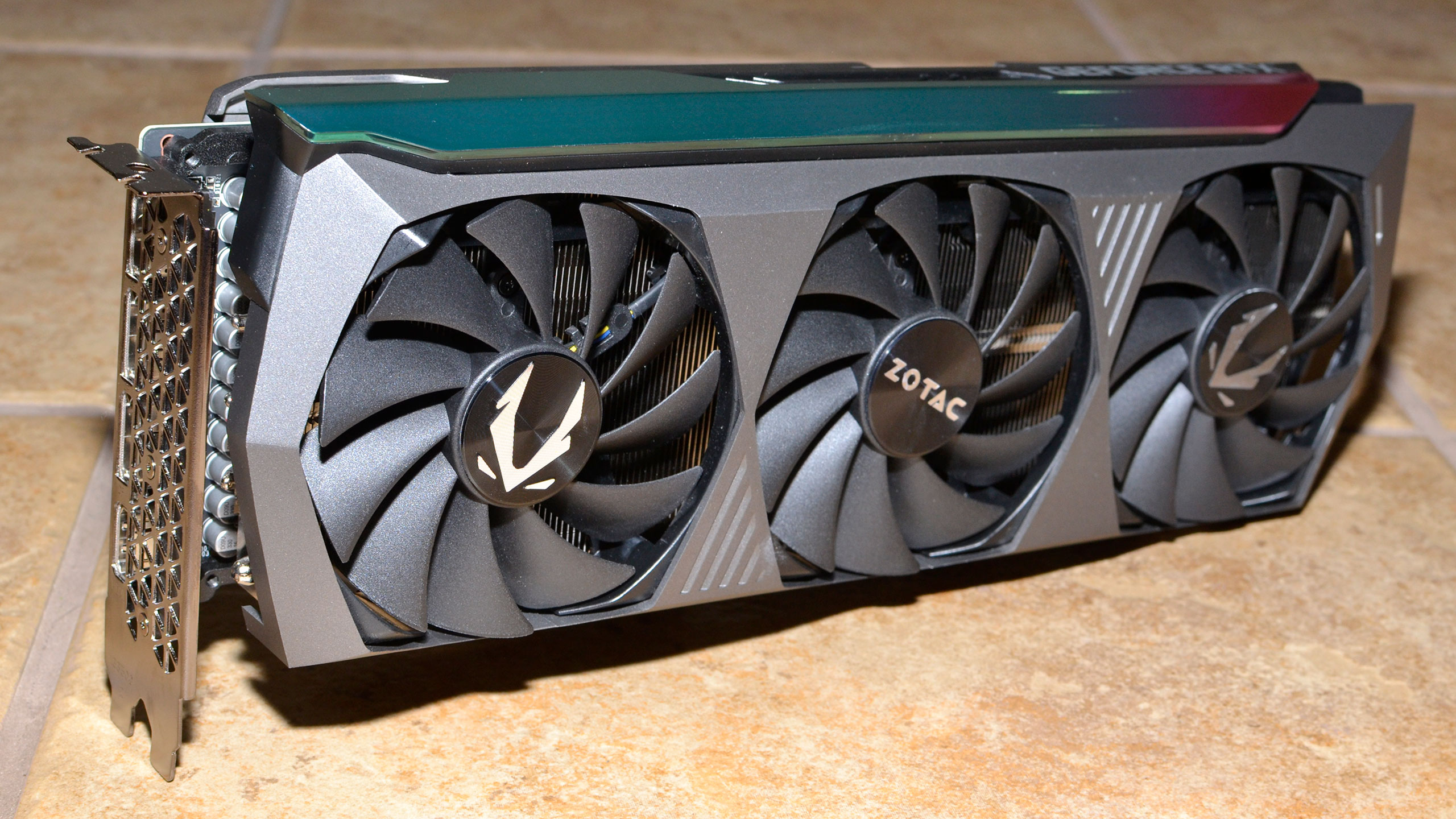
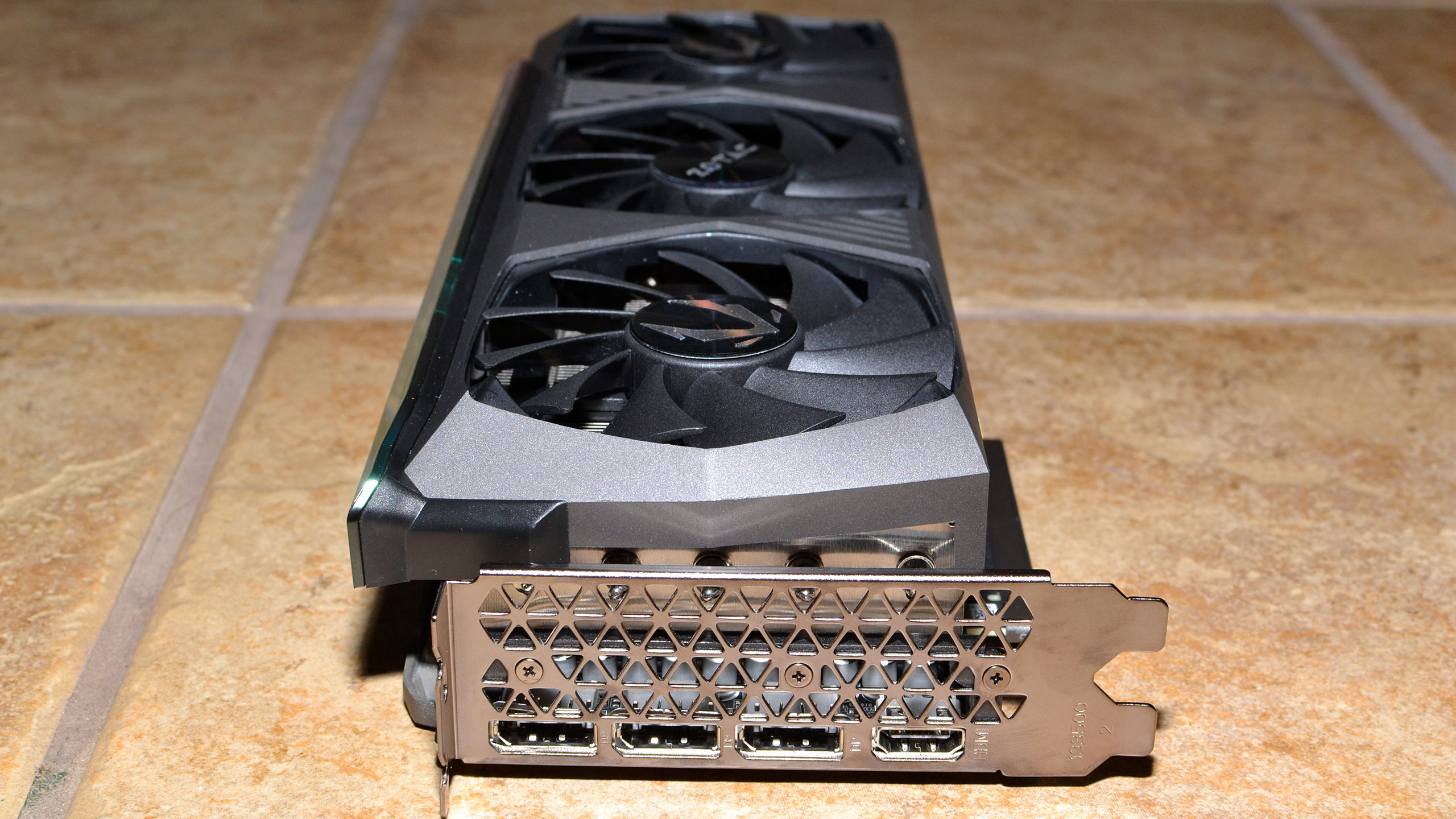
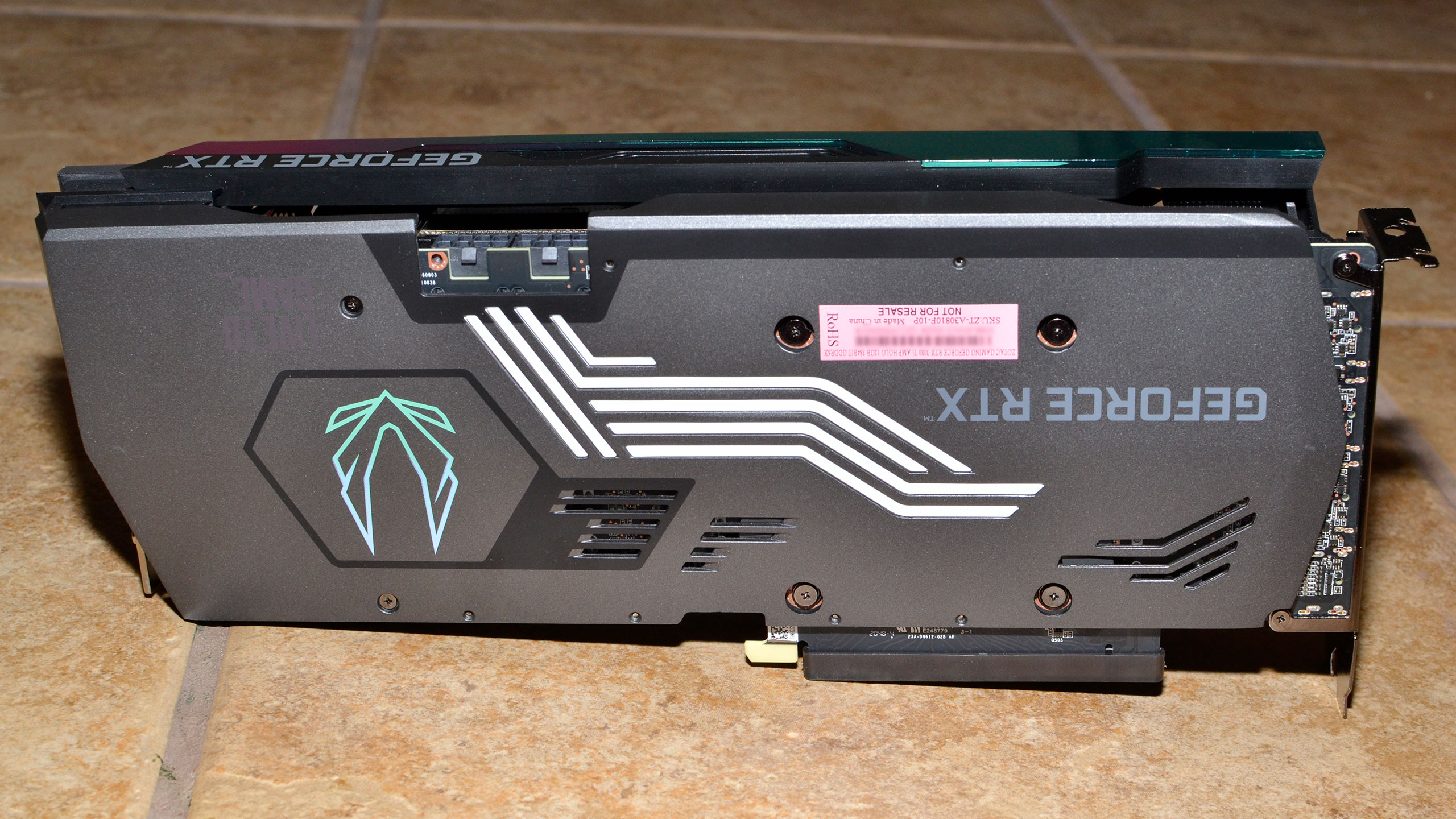

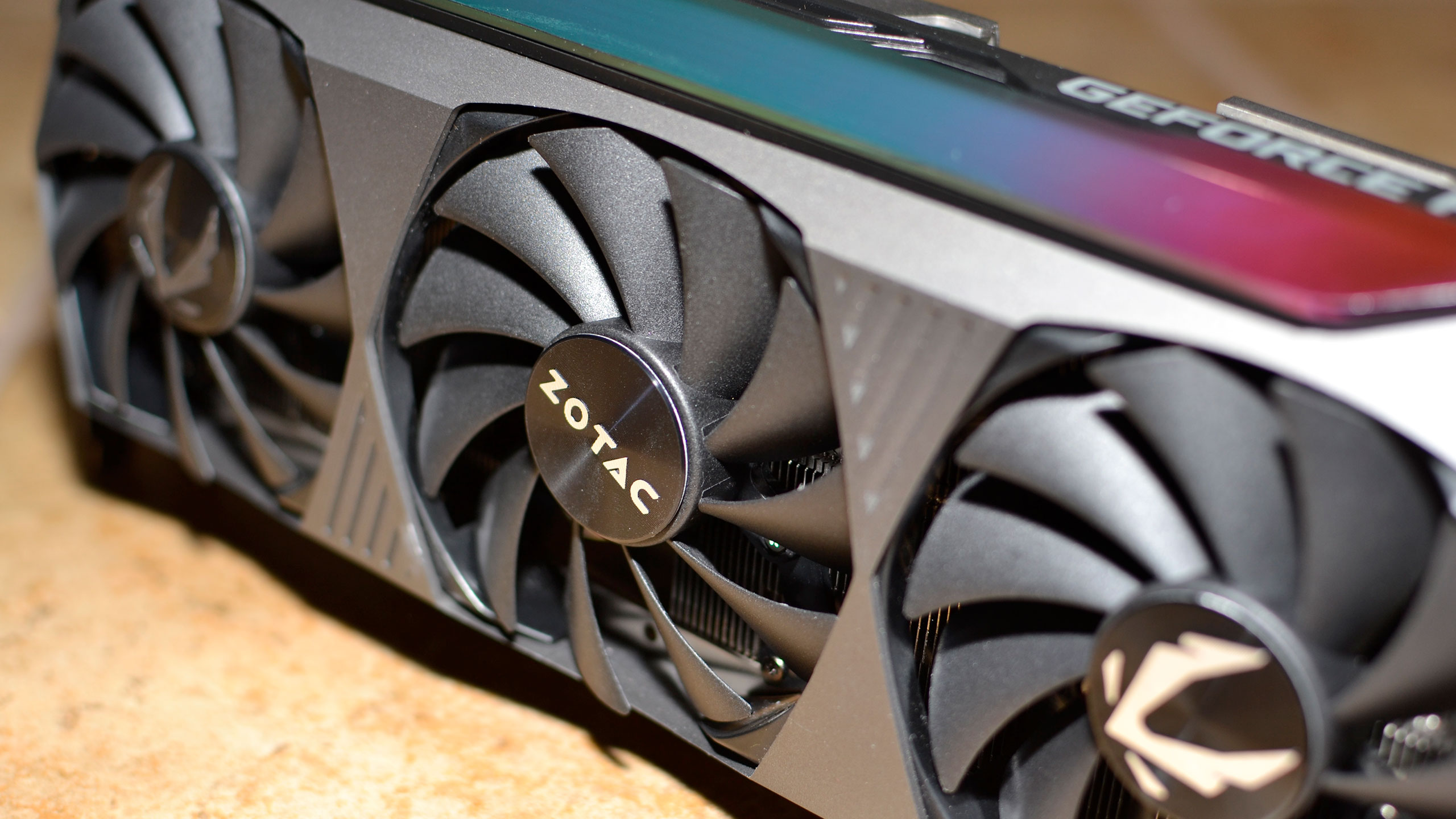
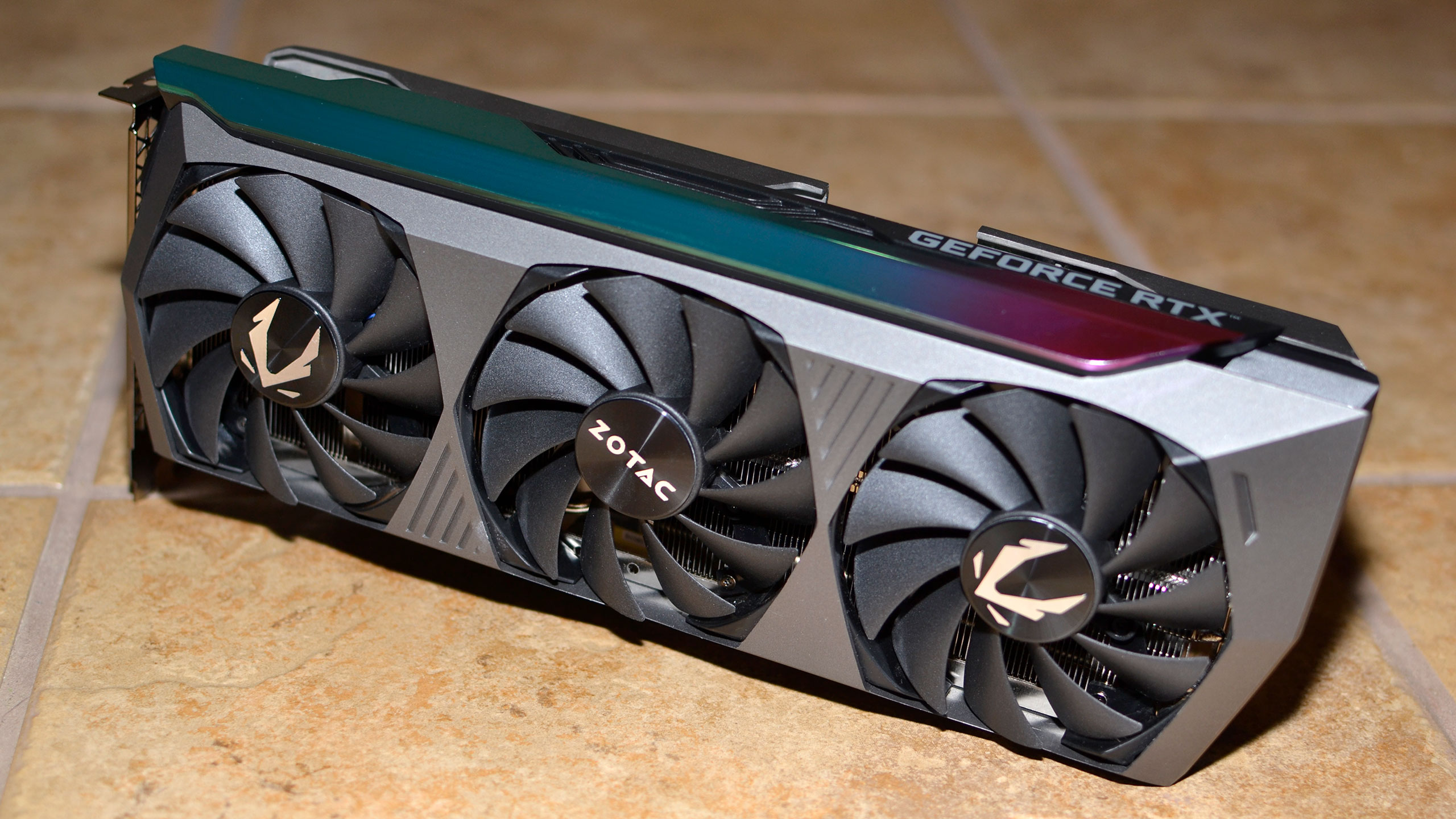

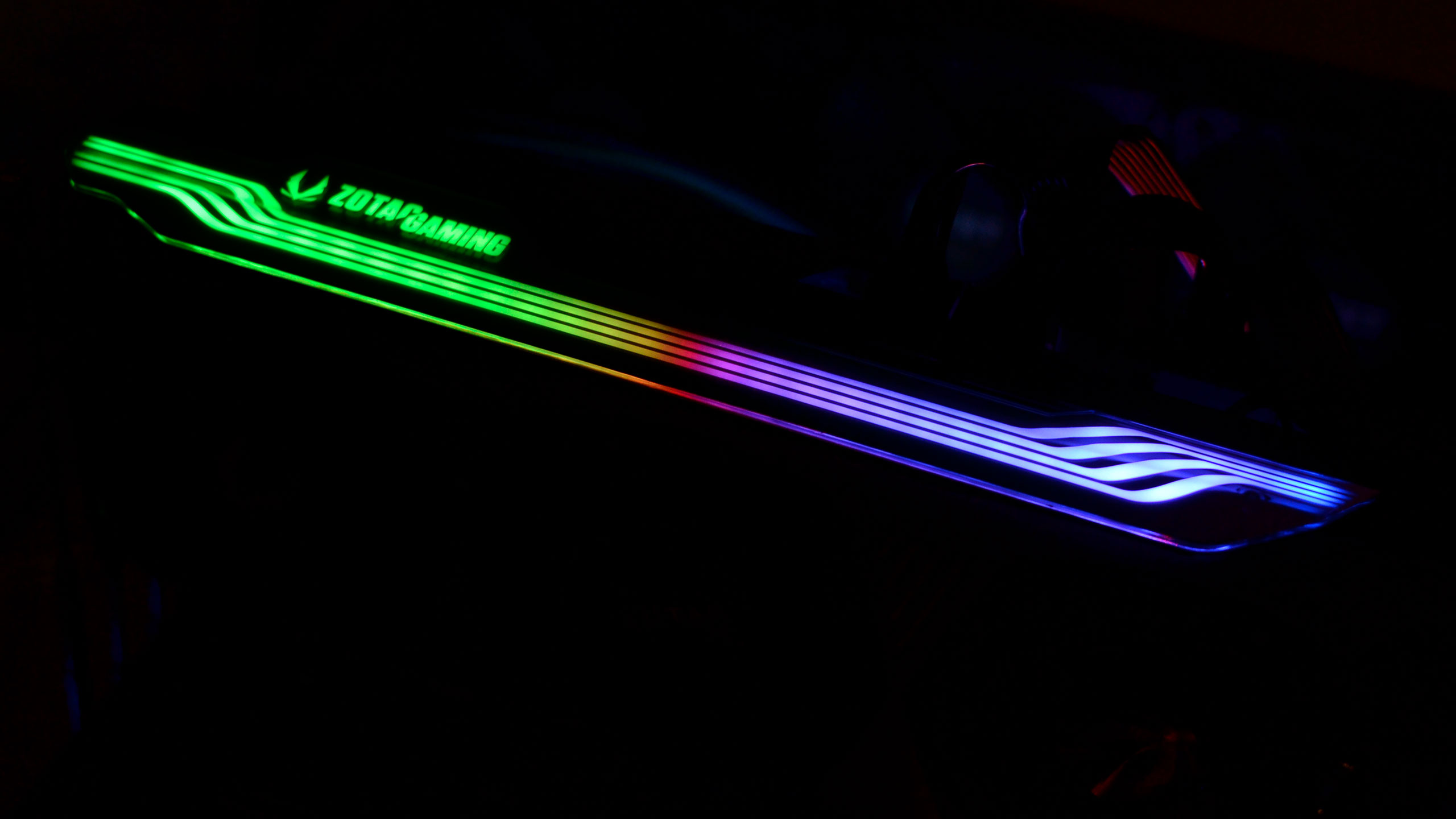
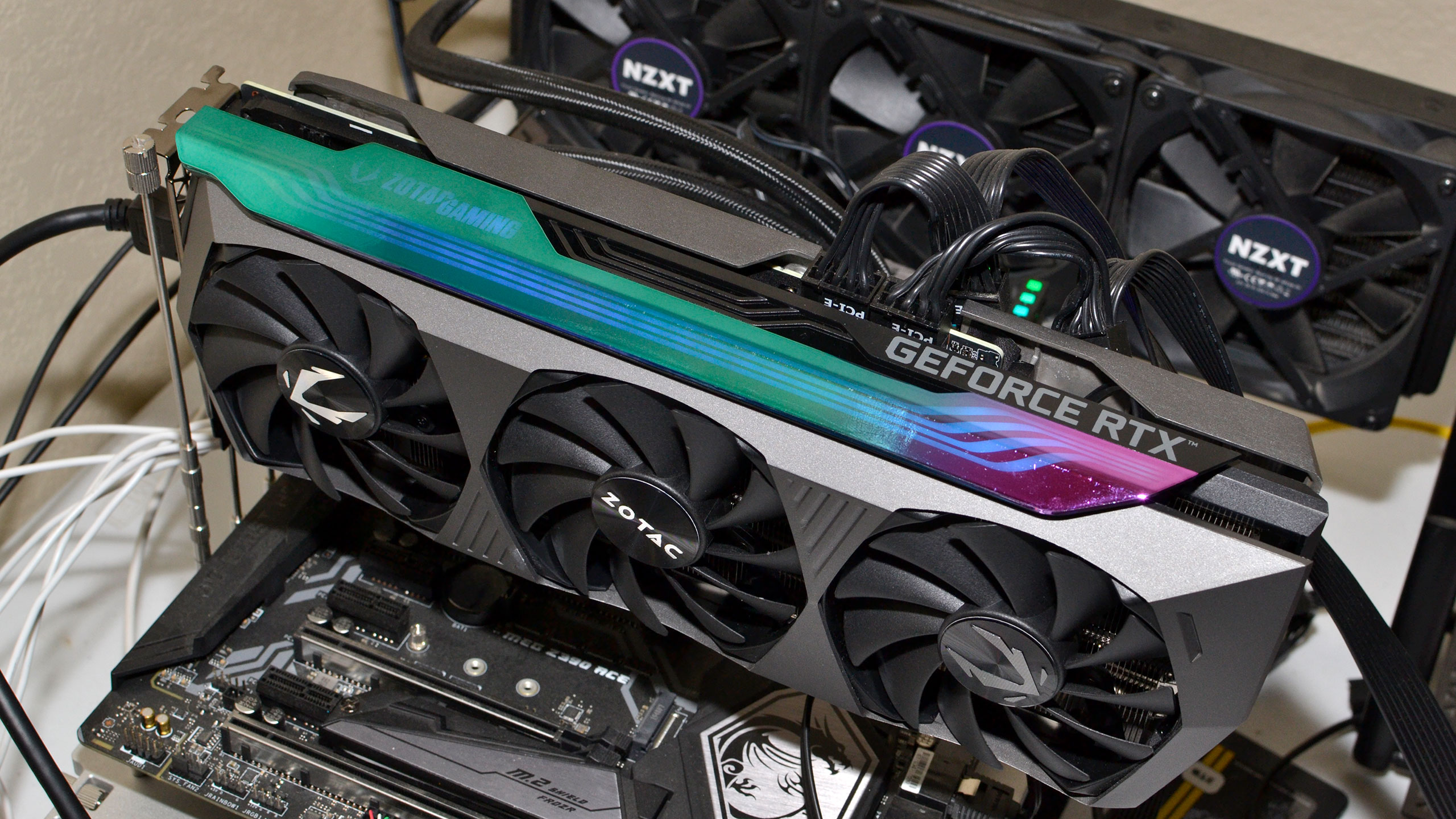
The RTX 3080 Ti Amp Holo uses the same board design and cooler as the existing RTX 3090 Amp Holo and RTX 3080 Amp Holo, though we never actually reviewed either of those. It's a triple-slot card, and the "holo" part of the name apparently refers to the iridescent coating on the strip around the RGB Zotac Gaming logo. The card uses programmable lighting, so you can have it blink, cycle through the colors of the rainbow, or a few other effects. There's additional RGB lighting on the back of the card, with some lines and a Zotac logo.
The Amp Holo tips the scales at just over 1.5kg, making it a rather chunky card. It's also a pretty long card, at around 12.5 inches (317mm according to Zotac), and it's 5.2 inches (131.8mm) tall. Needless to say, it's not the sort of card you'd want to try to cram into a compact case. Most of the bulk comes from the massive heatsink, which completely dwarfs the more modestly sized PCB.
All of the memory chips make contact with the heatsink as well, via 2mm or thicker thermal pads. This is all good news for anyone concerned with GDDR6X temperatures. The three fans also help with cooling, and each one measures about 90mm in diameter, though these lack the integrated rim that many newer cards opt for, since it helps increase static pressure and thus cooling performance.
Get Tom's Hardware's best news and in-depth reviews, straight to your inbox.
Other than the cooler and lighting, the remaining specs are pretty tame for such an expensive graphics card. Video output consists of a single HDMI 2.1 port, along with three DisplayPort 1.4 pots. The card has two 8-pin PEG power connectors, and the TDP maintains the same 350W value as the reference 3080 Ti (though in testing, the Zotac card actually used a bit less power than the Founders Edition).
Zotac RTX 3080 Ti Amp Holo Gaming Benchmarks
Our test configuration for the hardware and software remains unchanged from other recent reviews. We're using an 8-core/16-thread Core i9-9900K running stock clocks, but with DDR4-3600 memory and the XMP profile enabled. The CPU generally runs at 4.7GHz during our gaming benchmarks, though the slightly older Coffee Lake architecture can be a bit of a bottleneck at lower resolutions.
Since we've already tested ray tracing and DLSS performance using the reference Founders Edition, for the third-party cards we're only going to look at our standard 13 game test suite, running at 4K, 1440p, and 1080p and ultra settings. Each test setting gets run multiple times, to ensure the consistency of our results. Considering the relatively similar specs on the Zotac 3080 Ti and the 3080 Ti FE, we should see very little difference between the two cards.
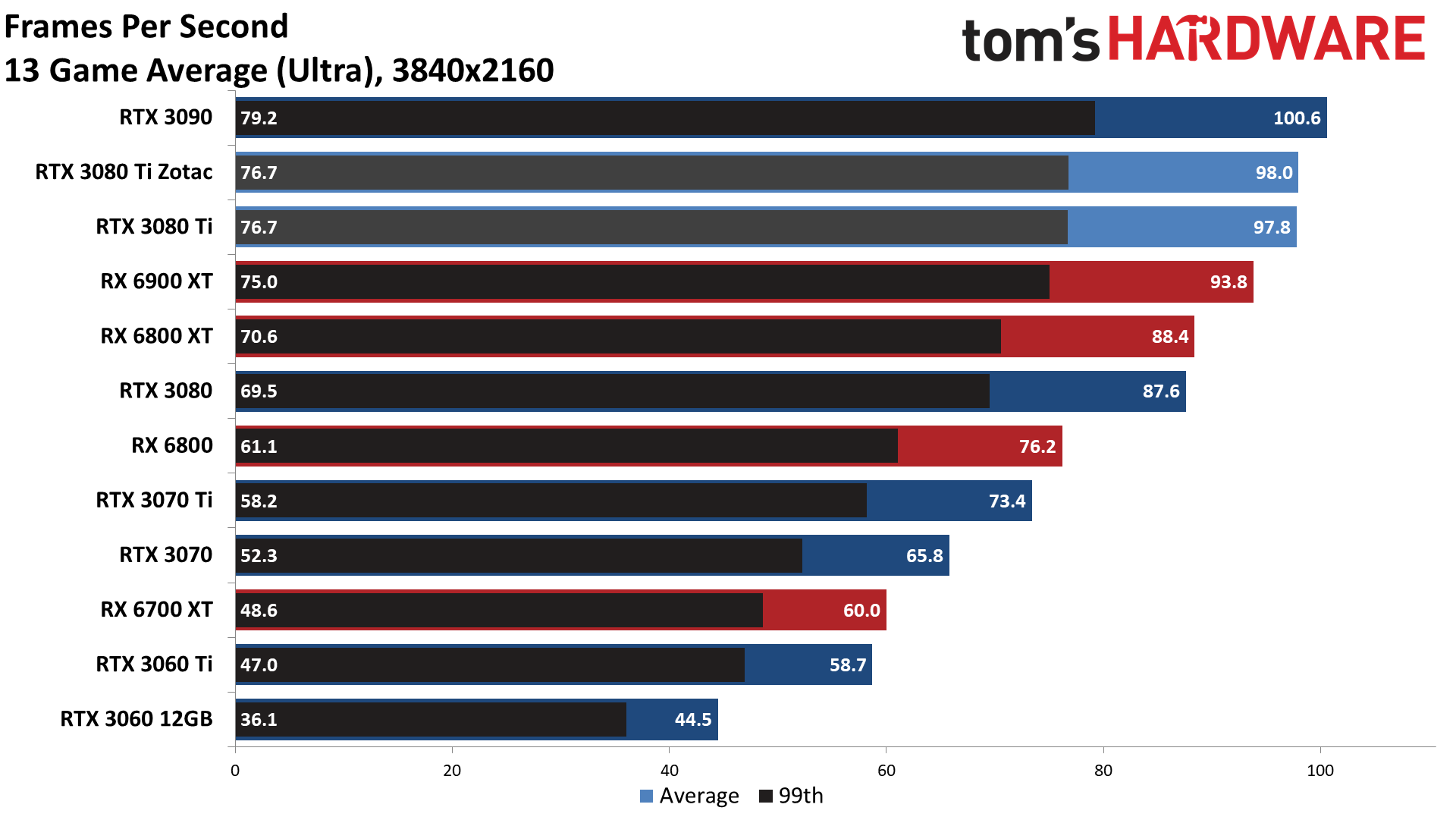
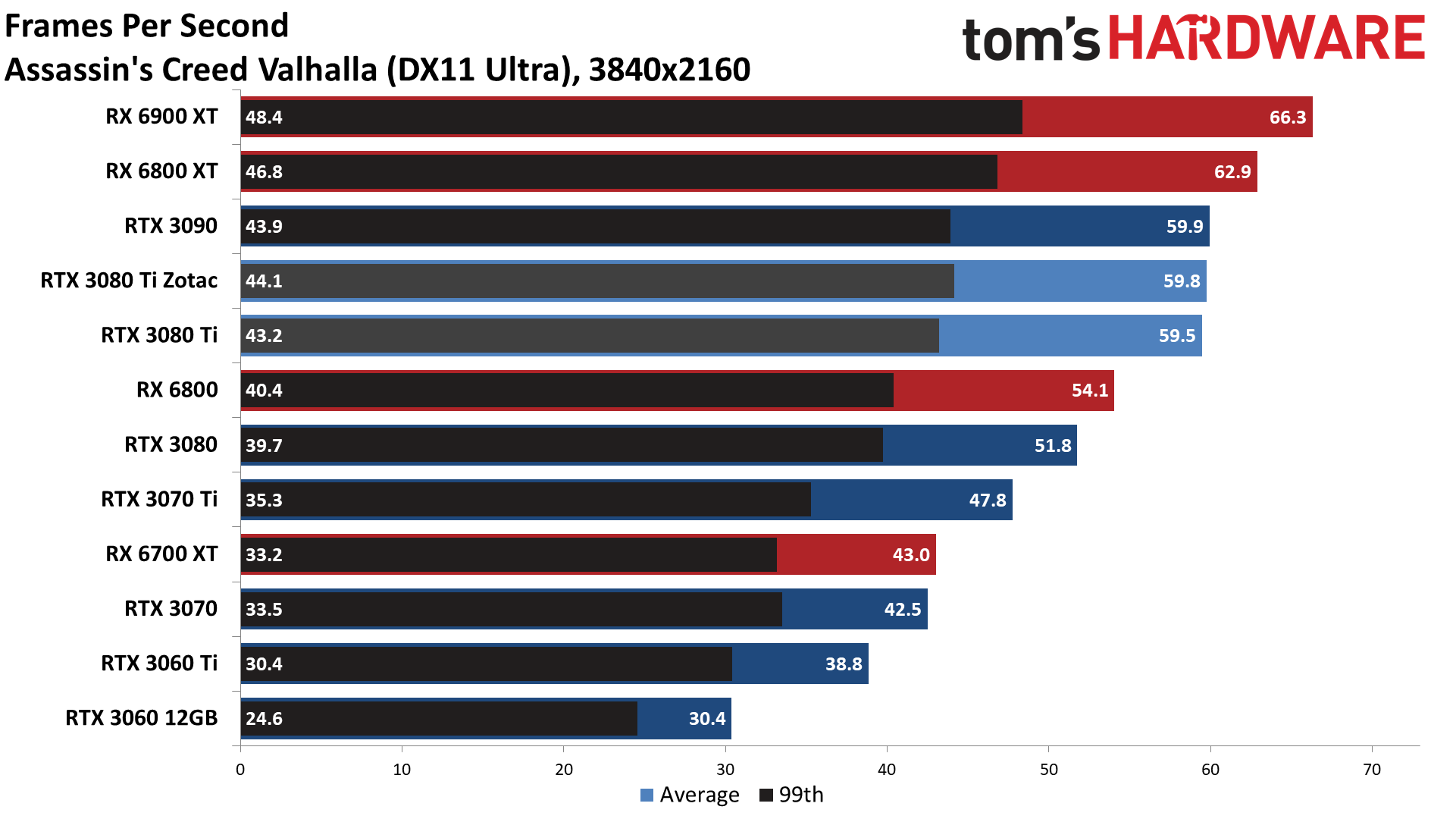


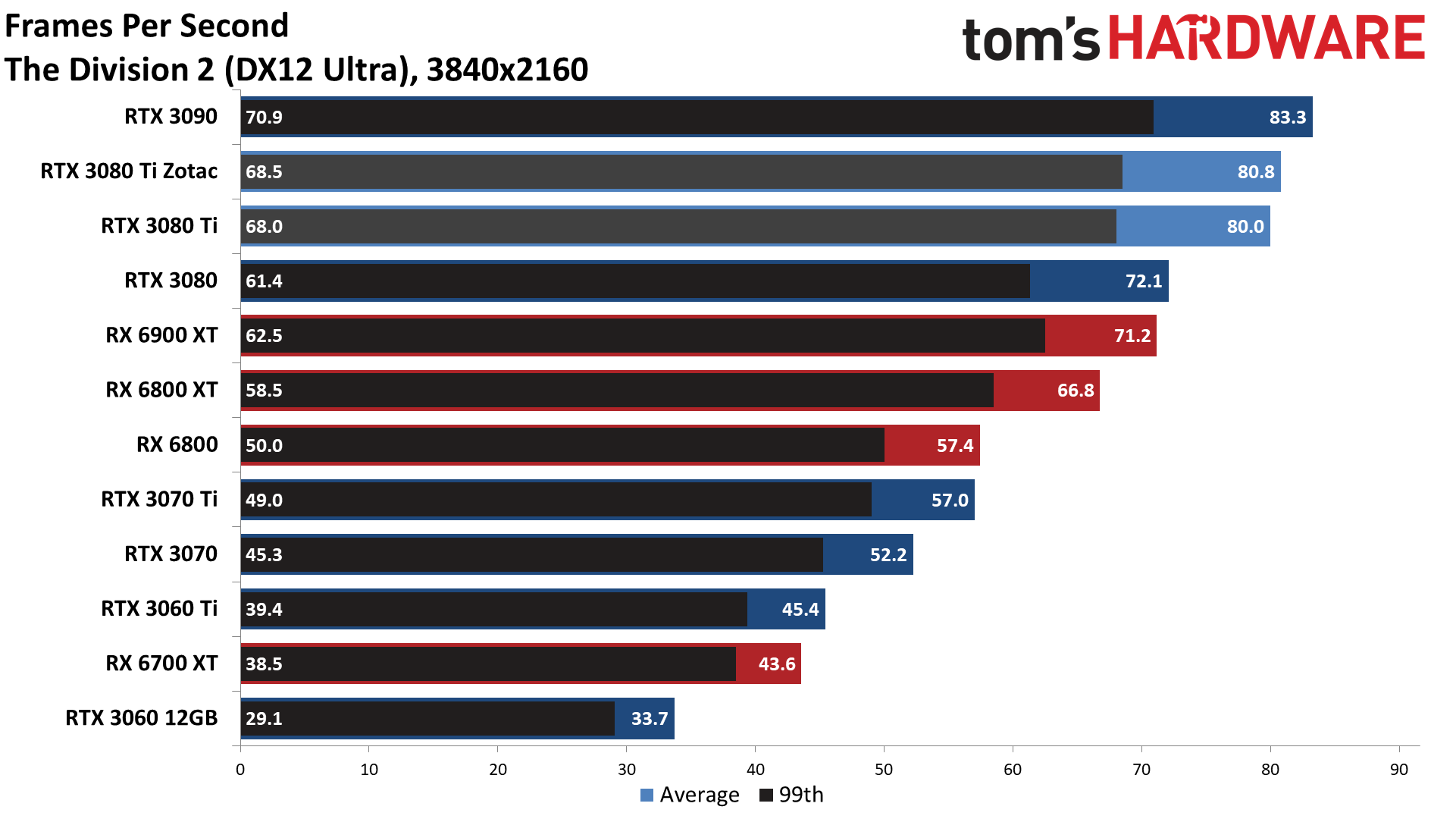
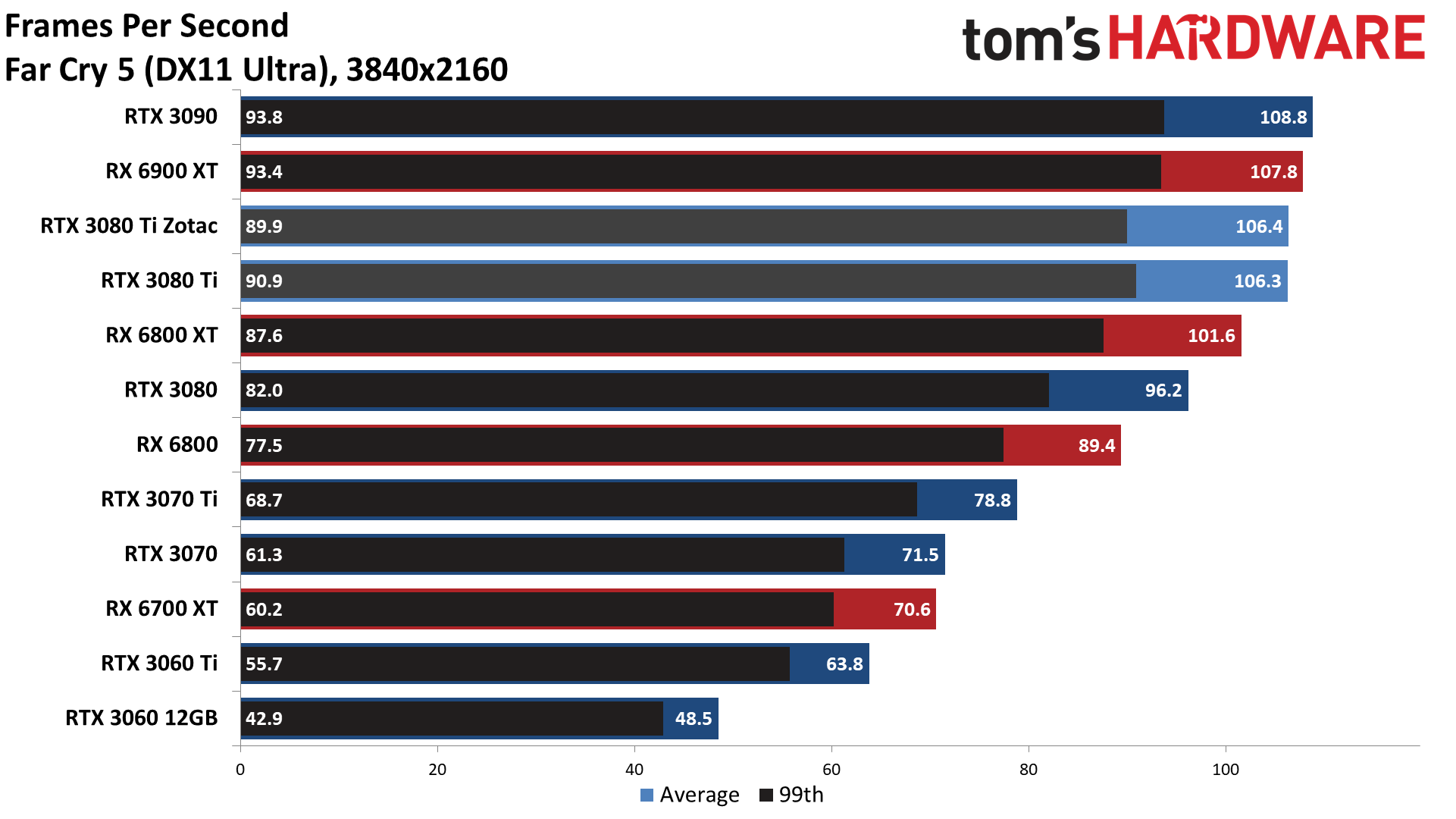
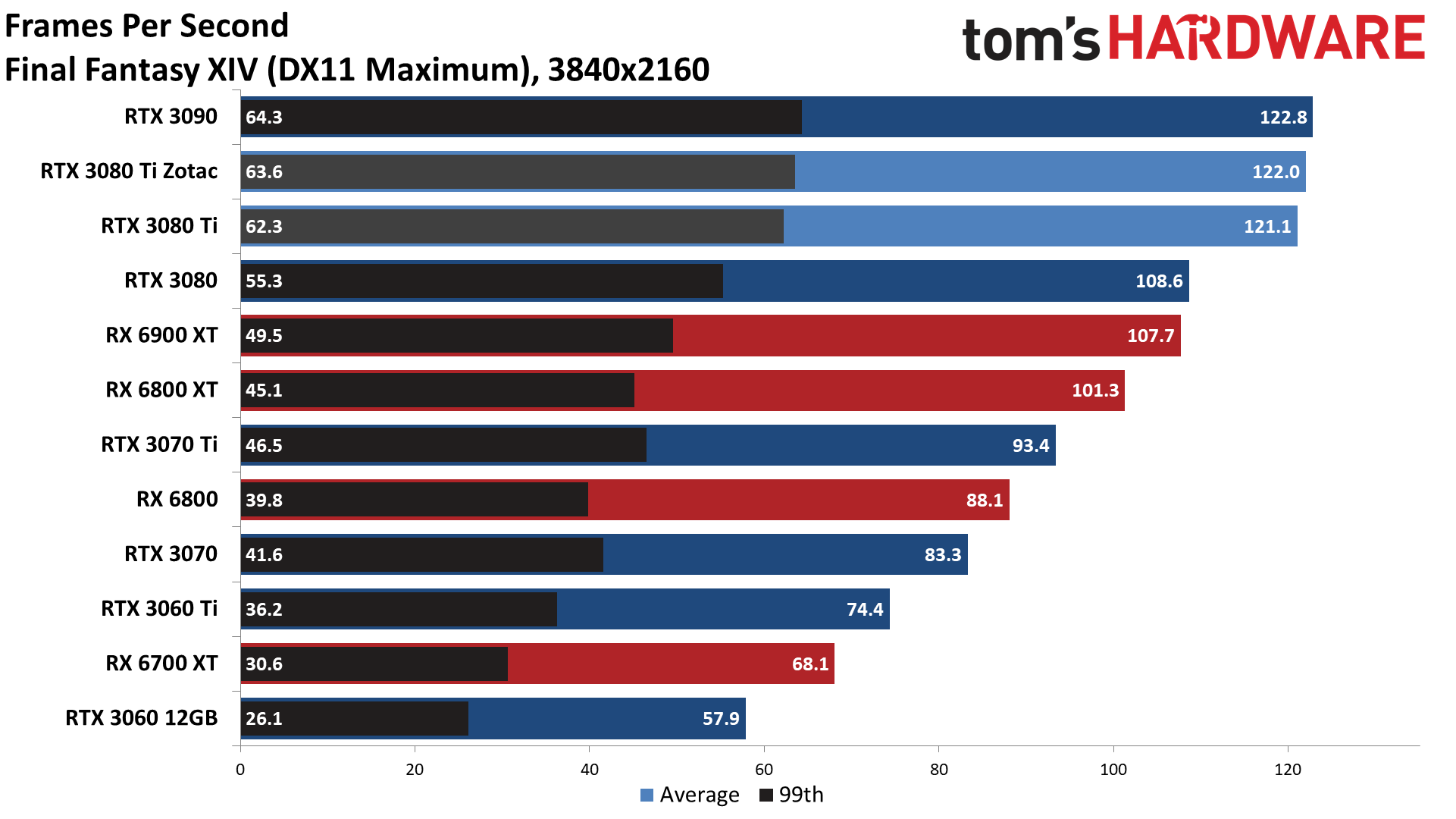


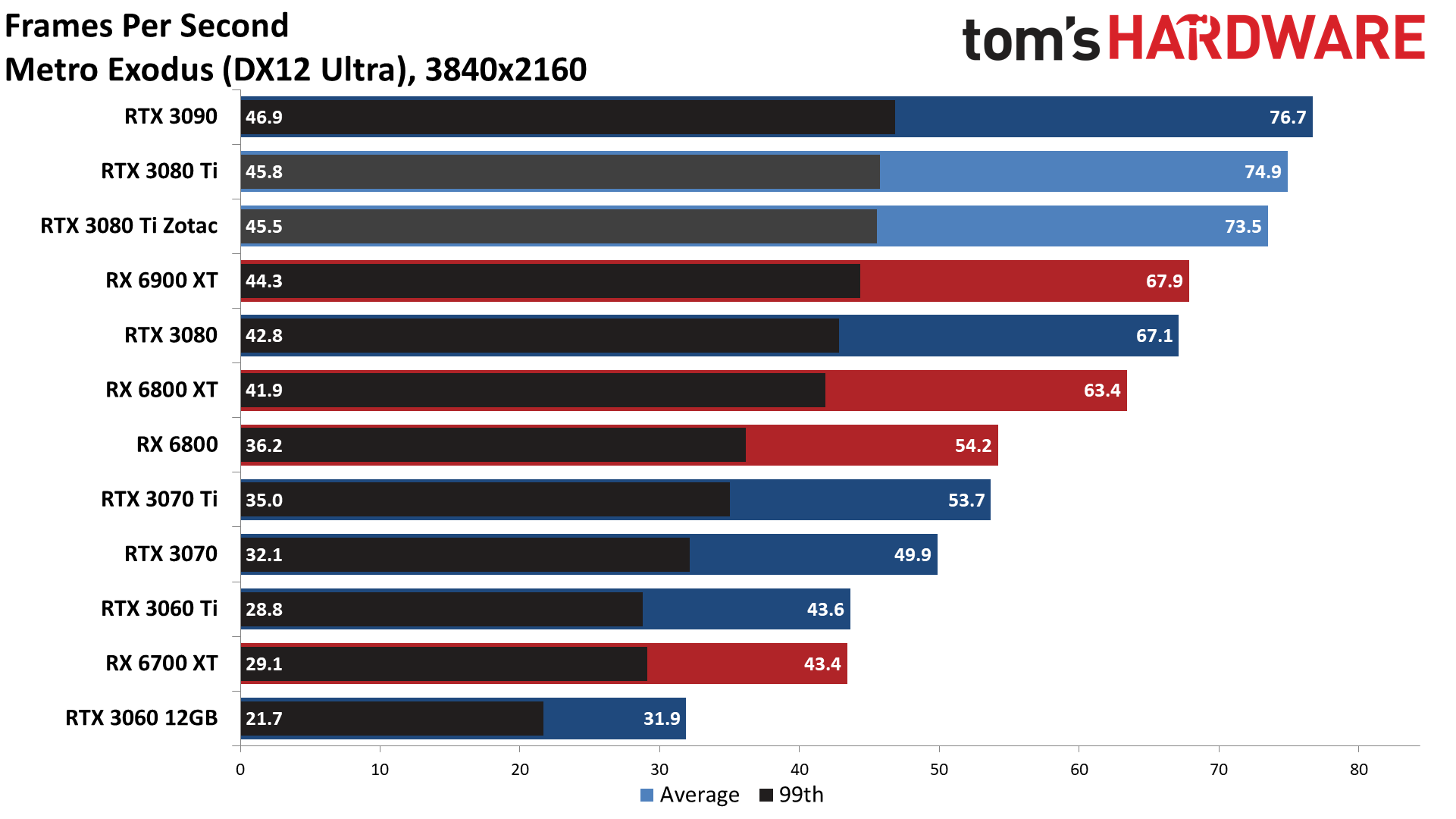
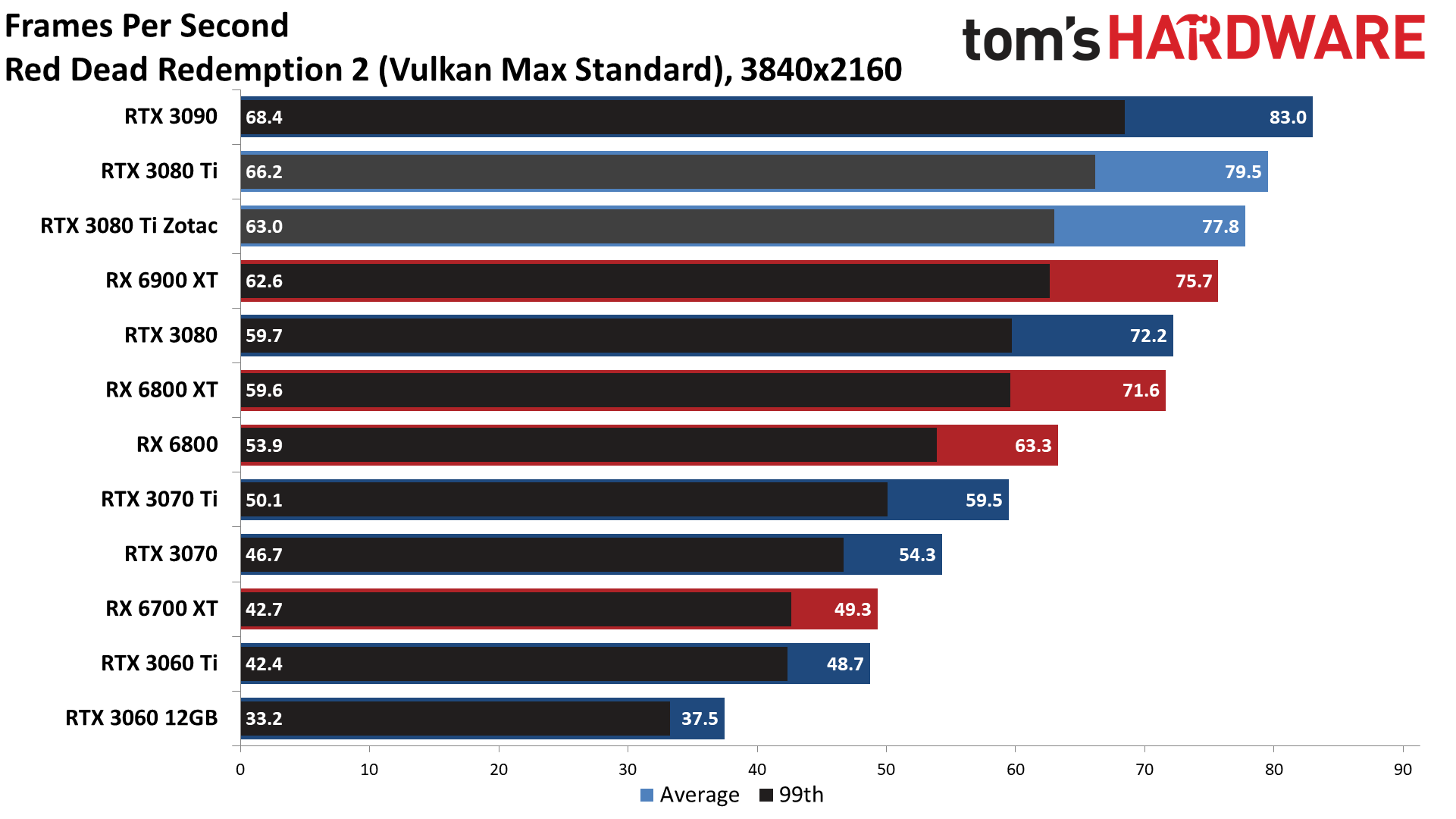
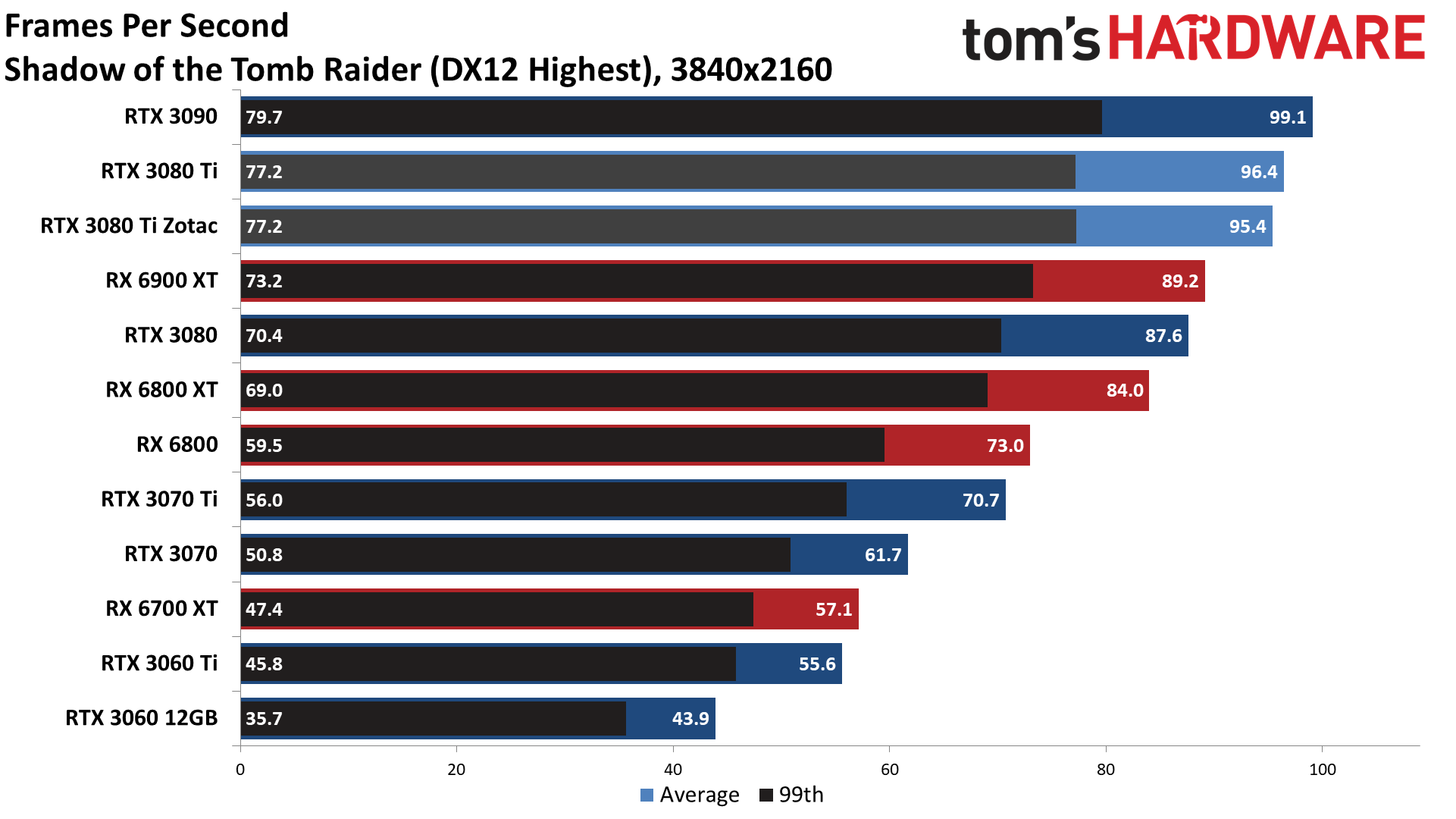

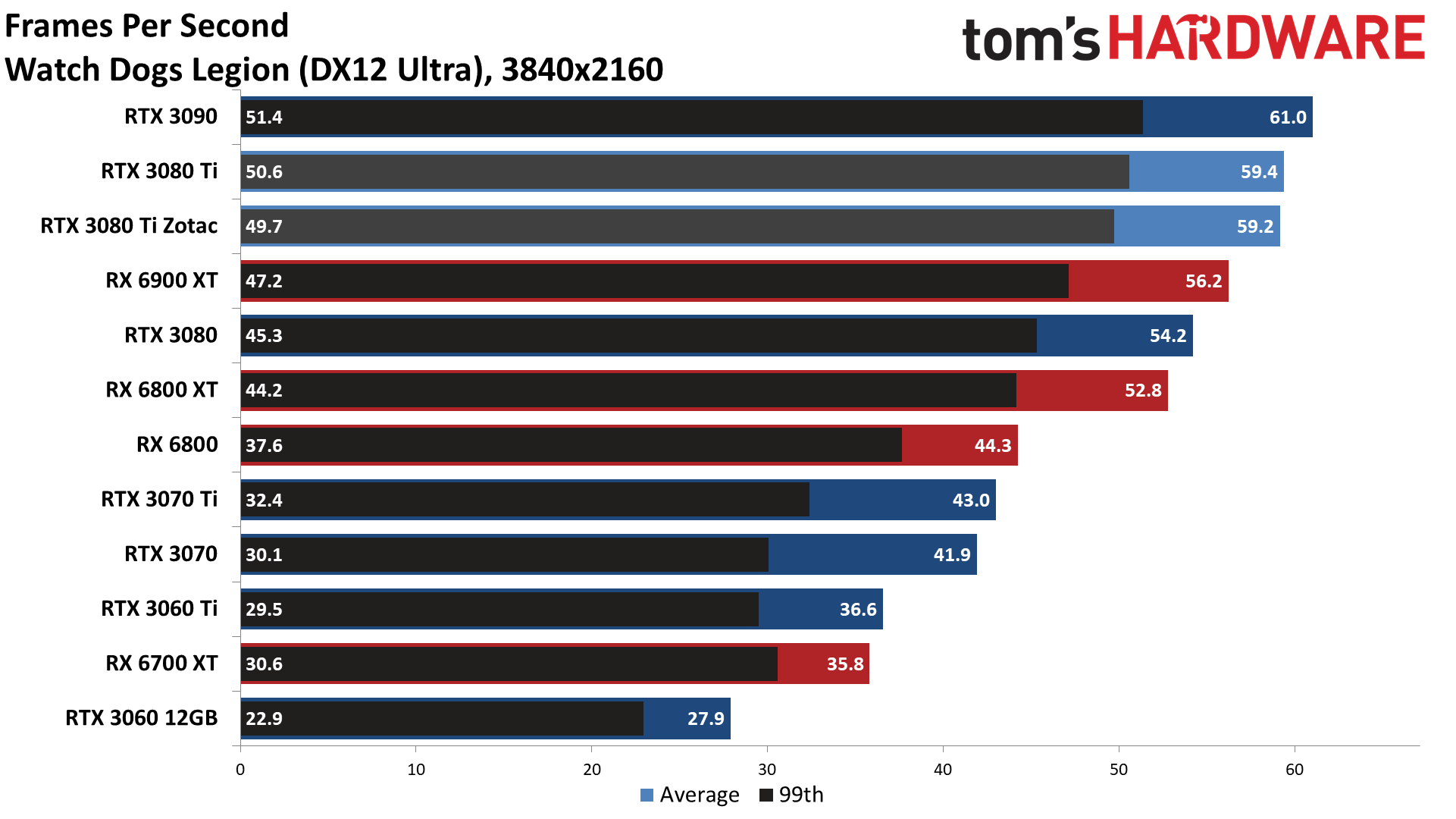
Yeah, that about sums it up for performance! Overall, the Zotac card came in 0.2 fps faster than the Founders Edition. The individual charts show a 1–3 percent variation, but that's within the margin of error. There's not much more to say here, other than Zotac delivered imperceptibly higher frame rates than the reference card.




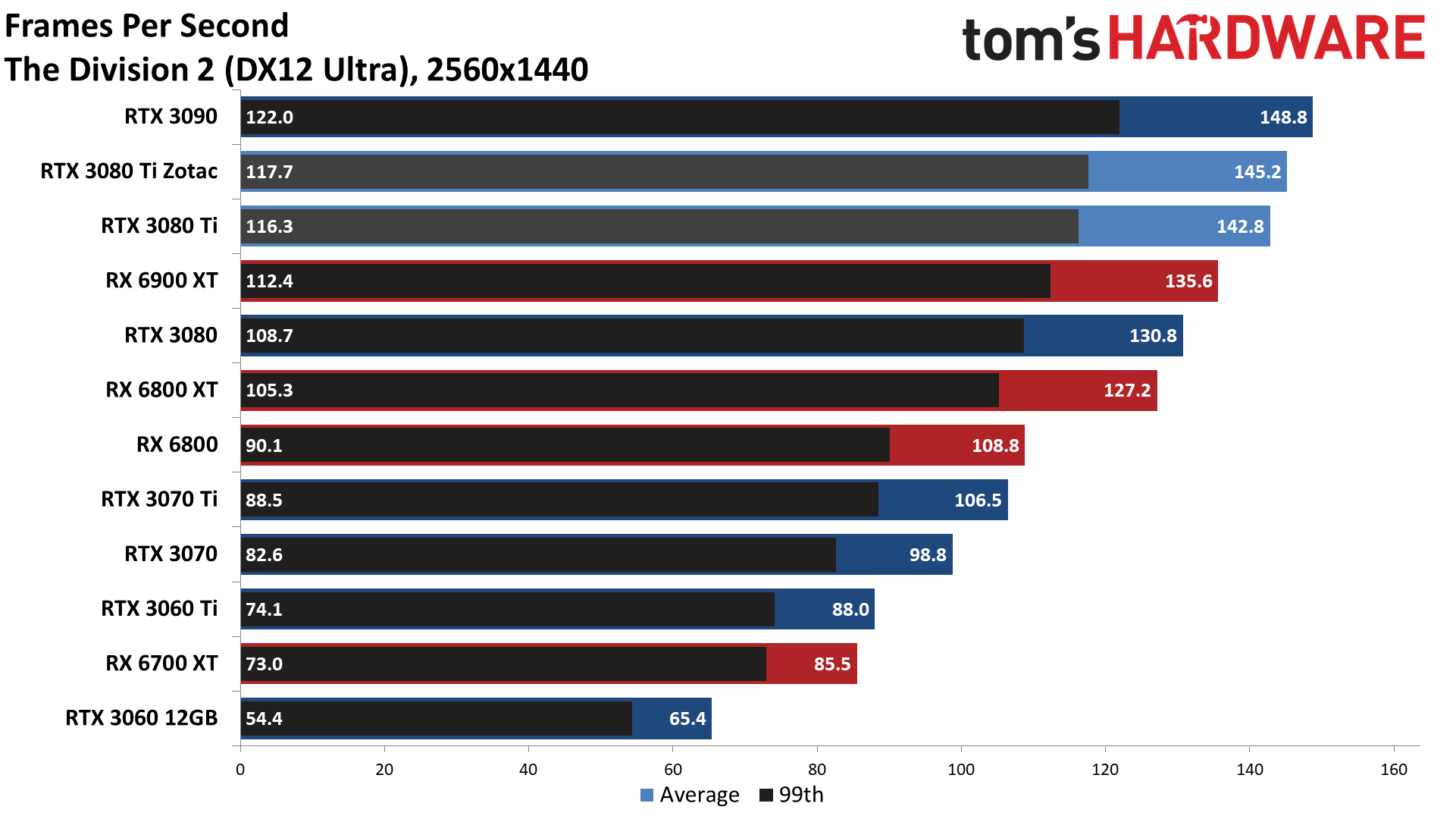


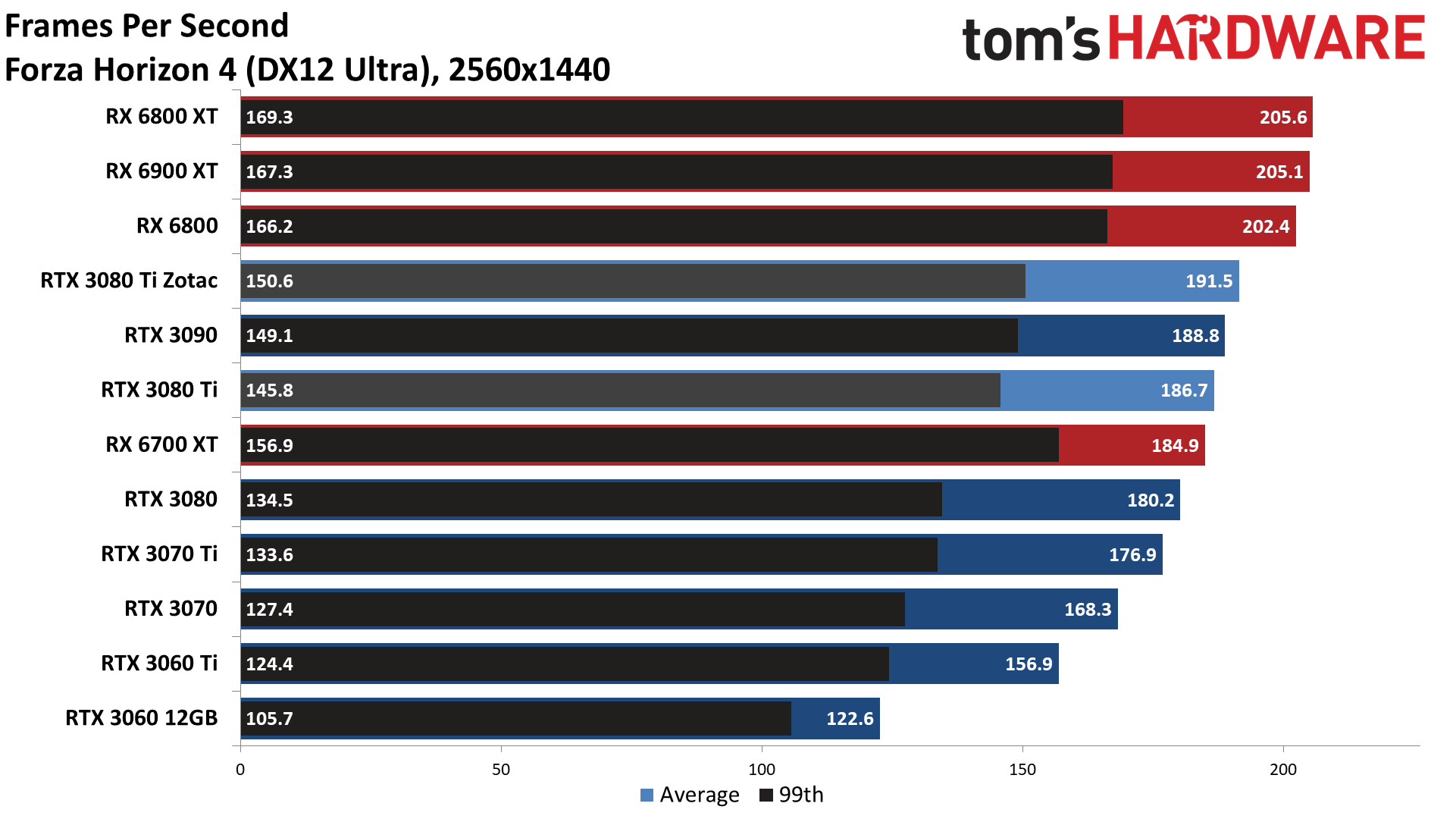
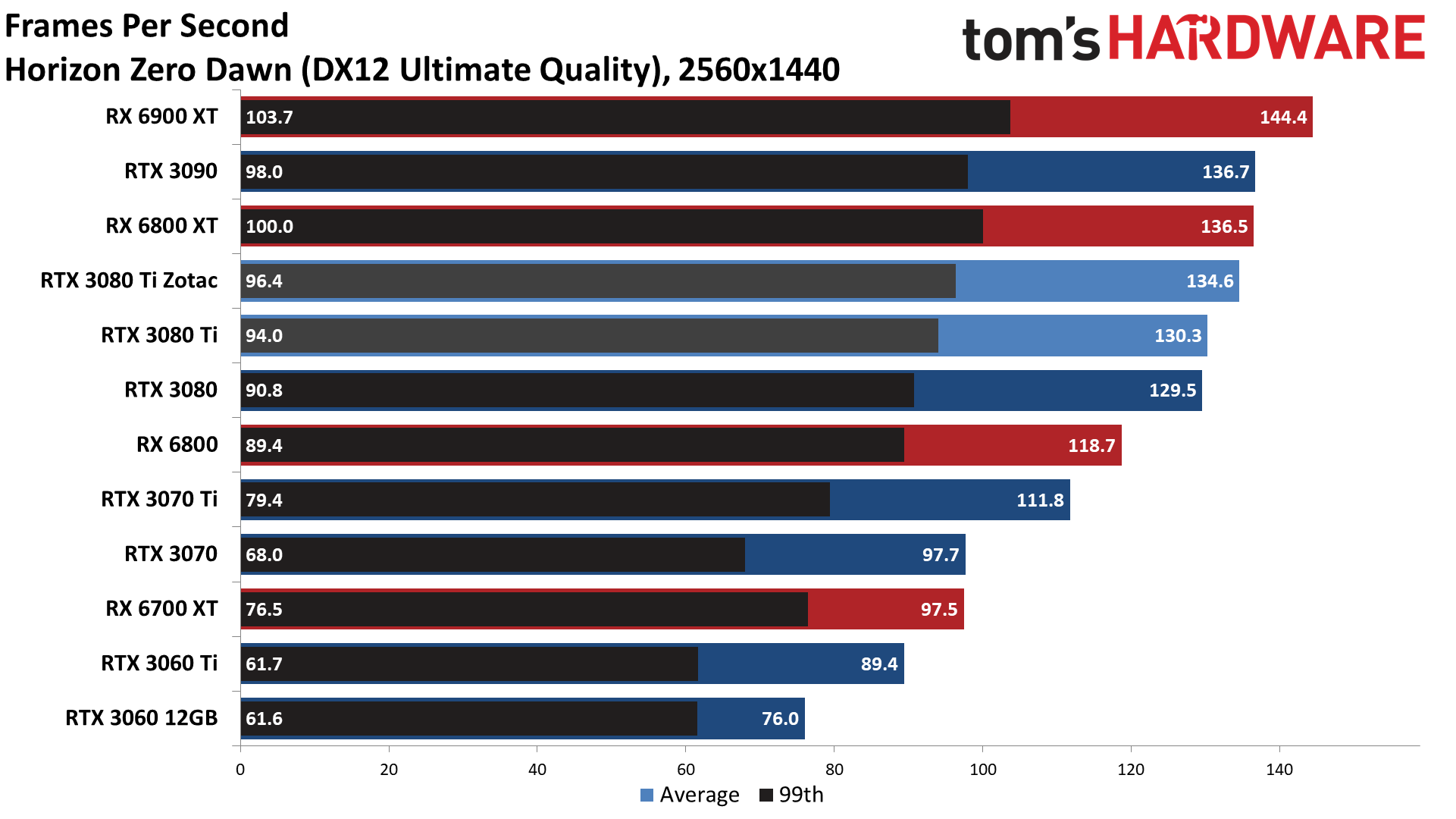

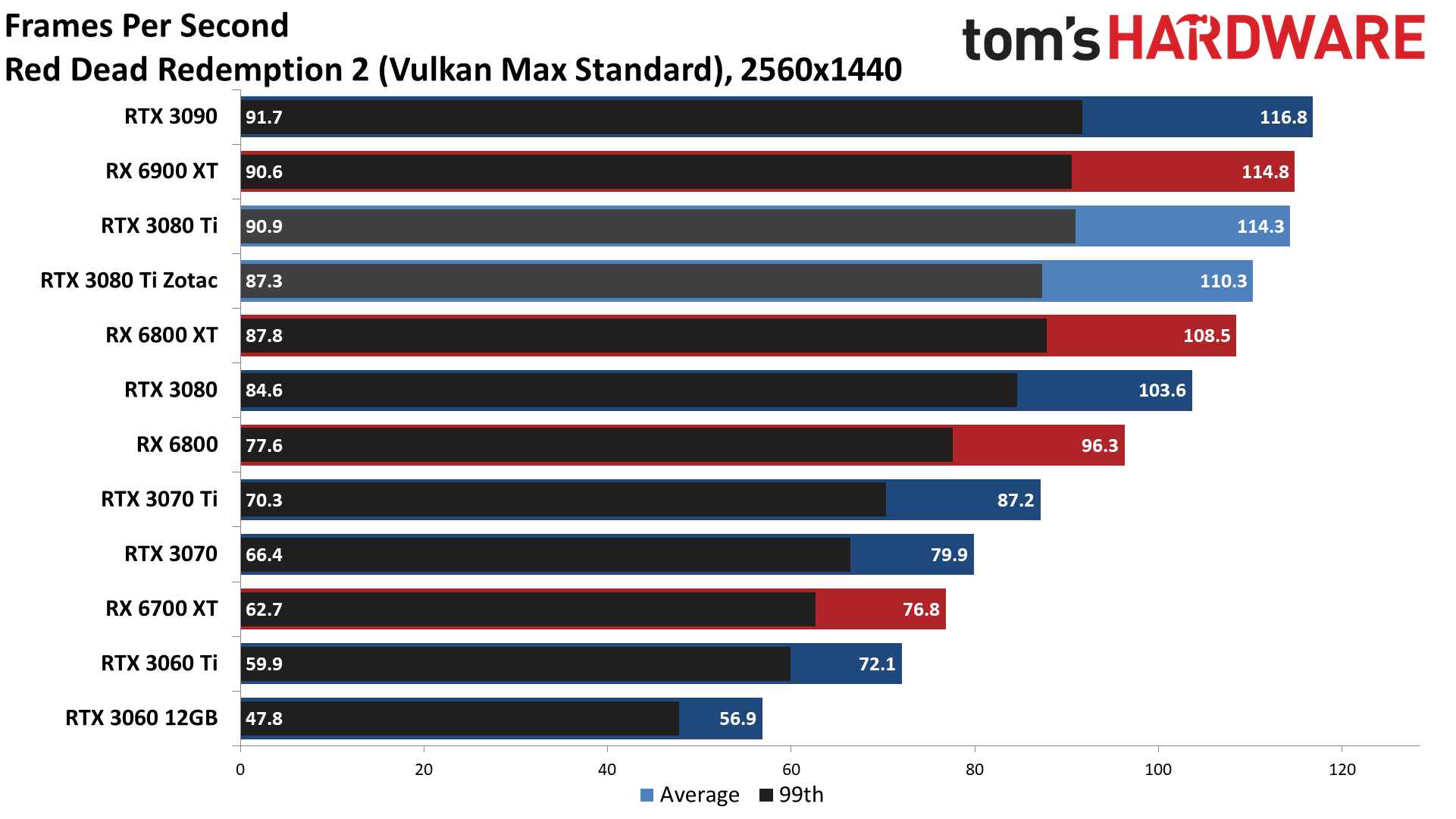
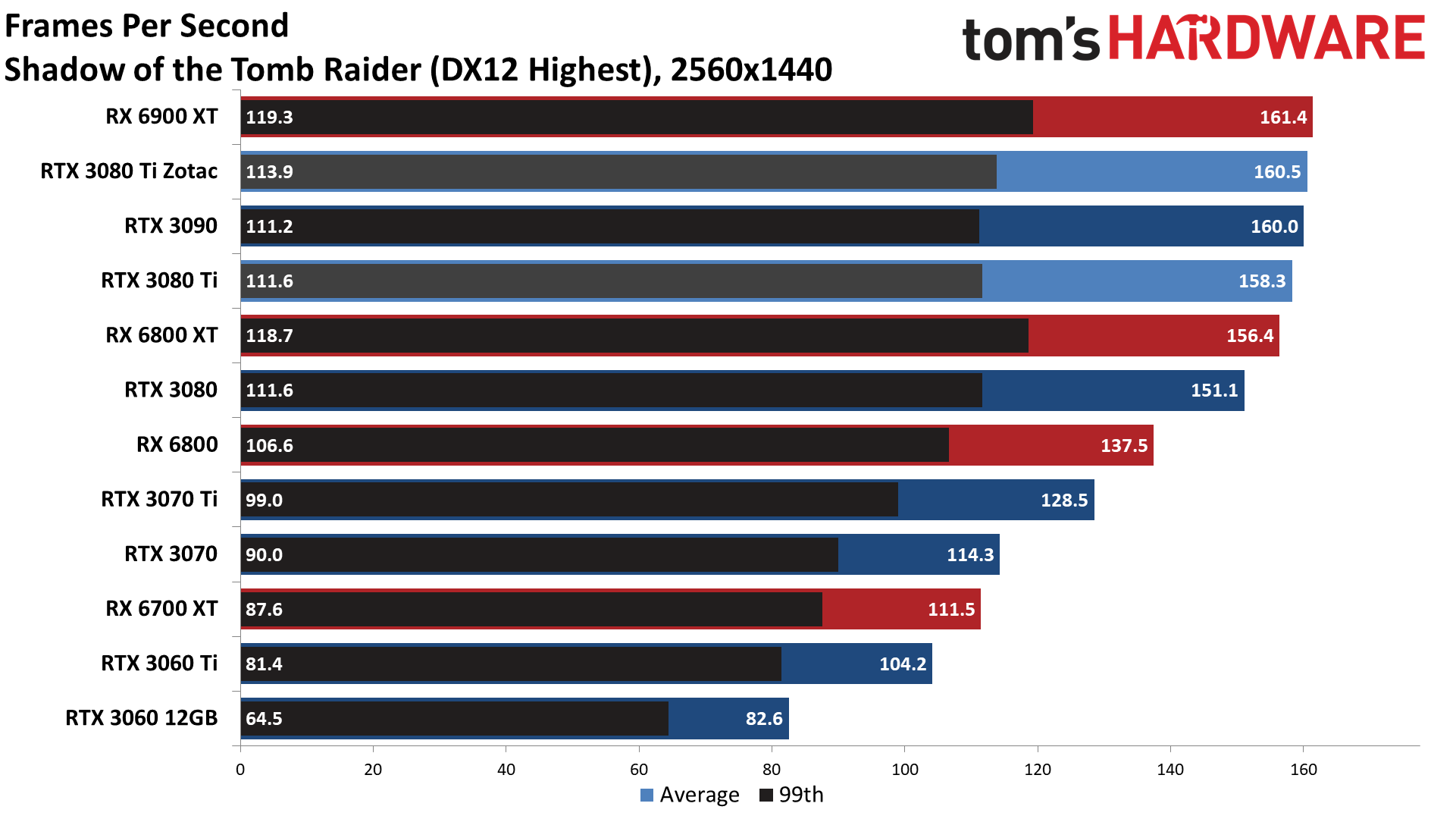
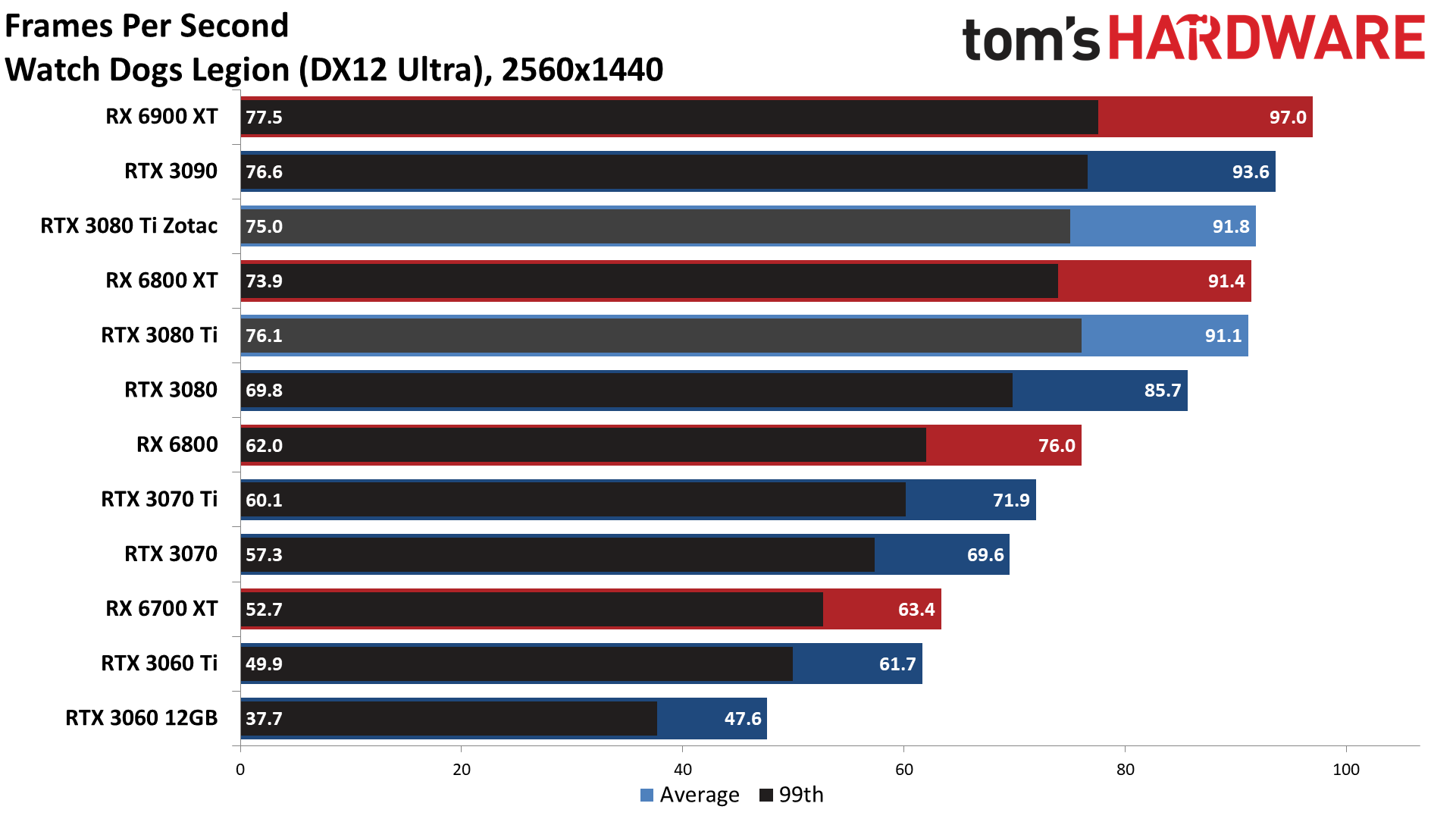
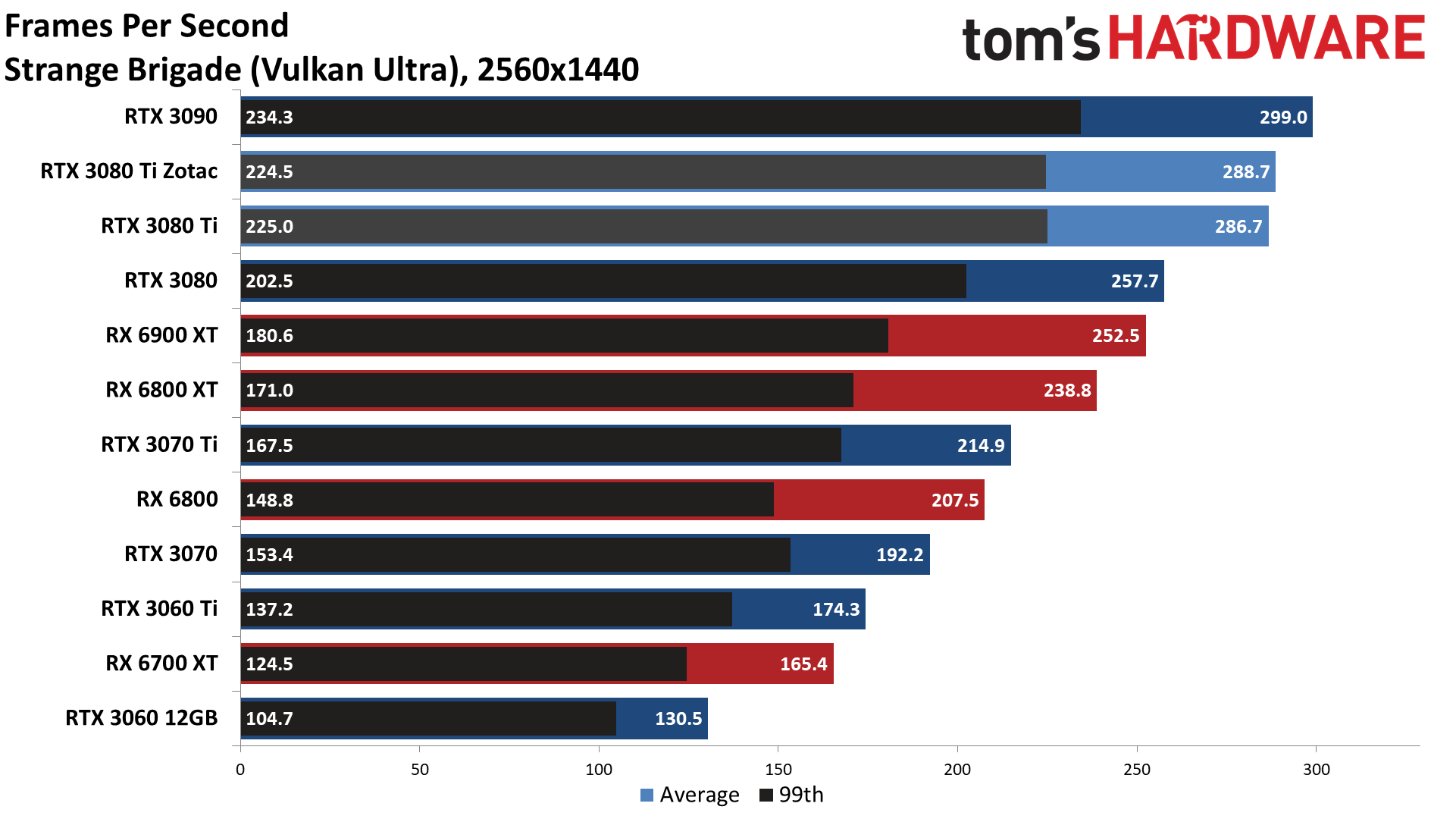
Dropping to 1440p, the pattern remains the same. Here the Zotac card came in 0.9% faster than the Founders Edition, but anything less than 5% won't be noticeable—it's just noise in the mix.

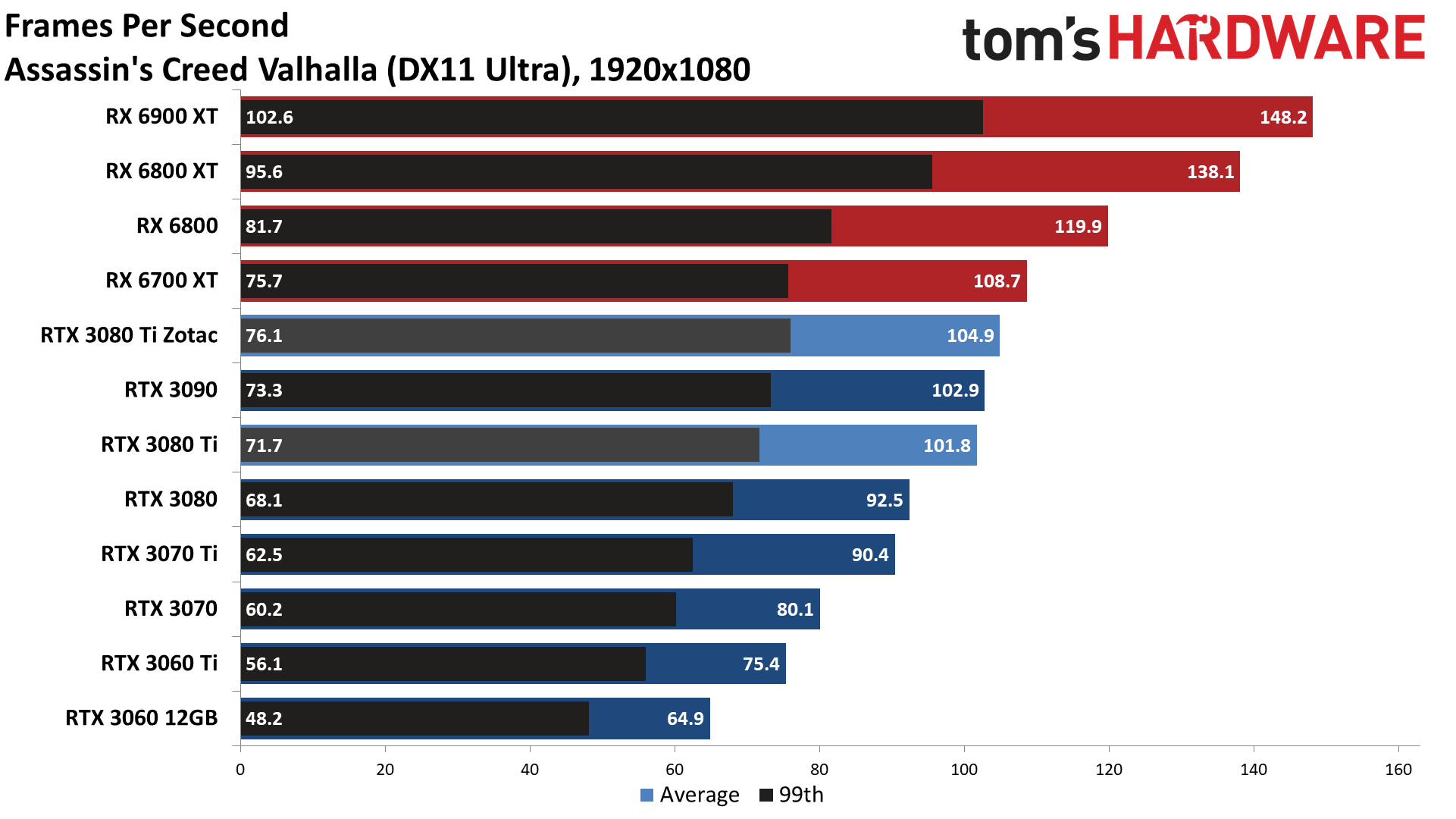
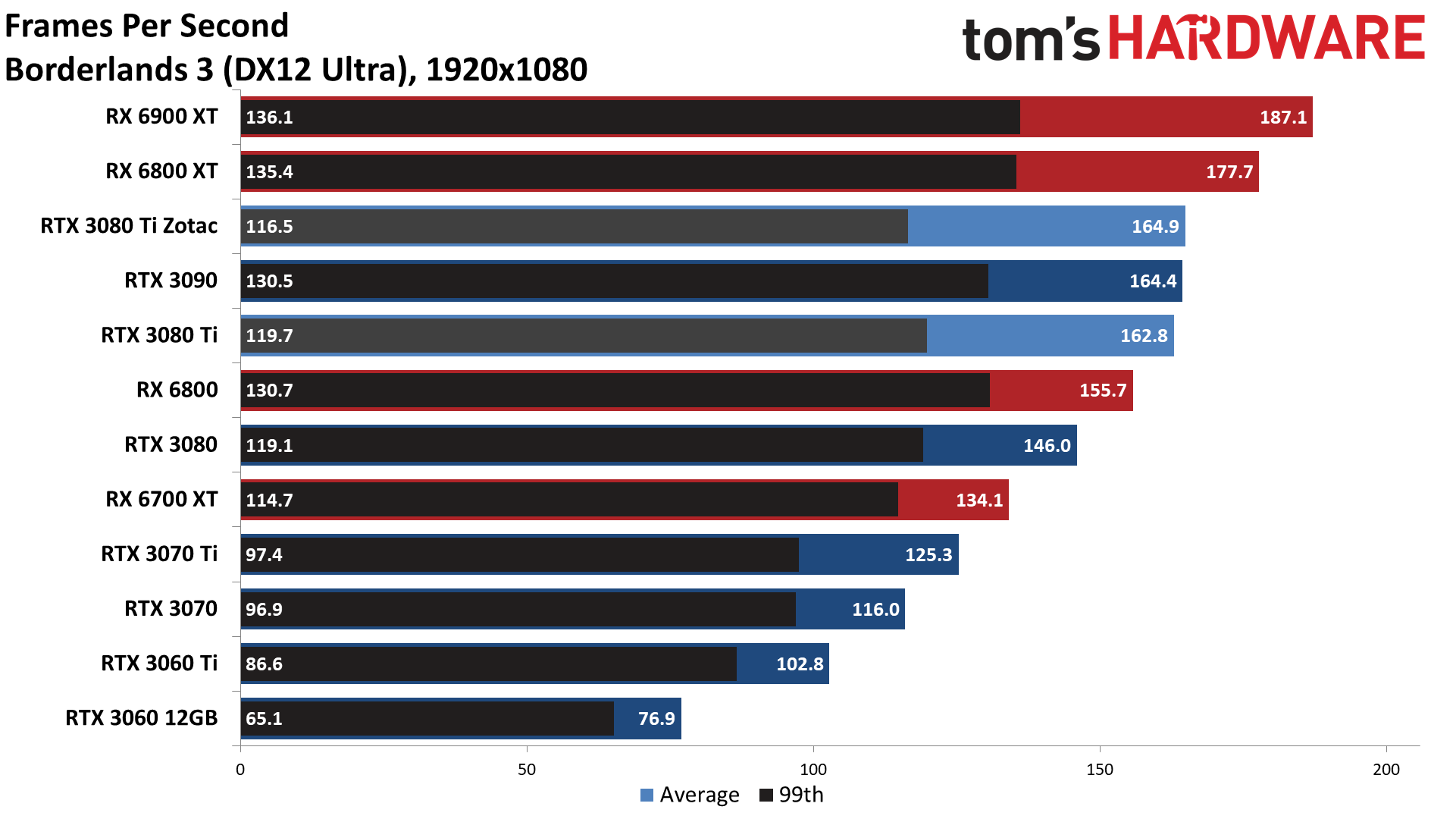
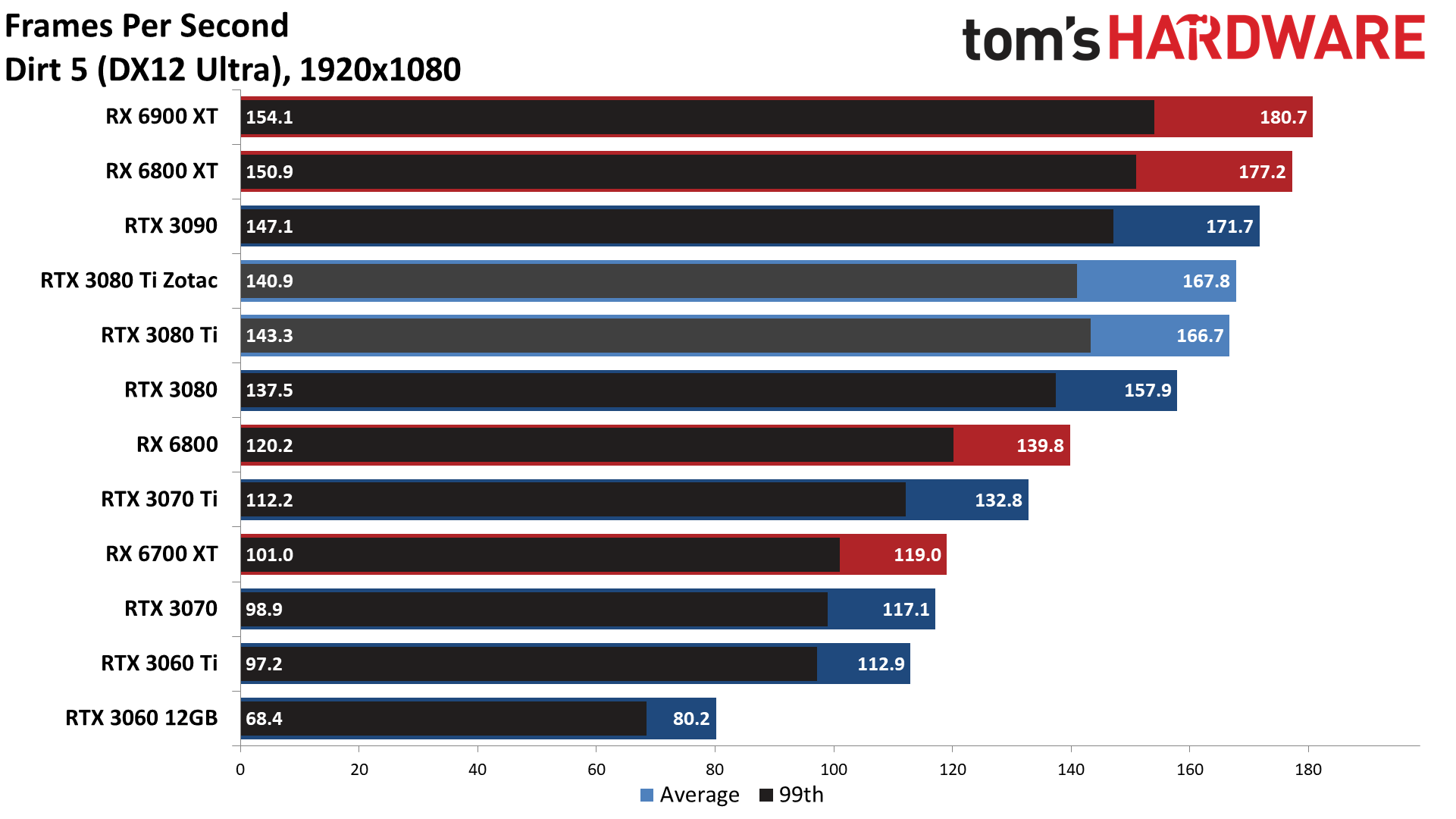
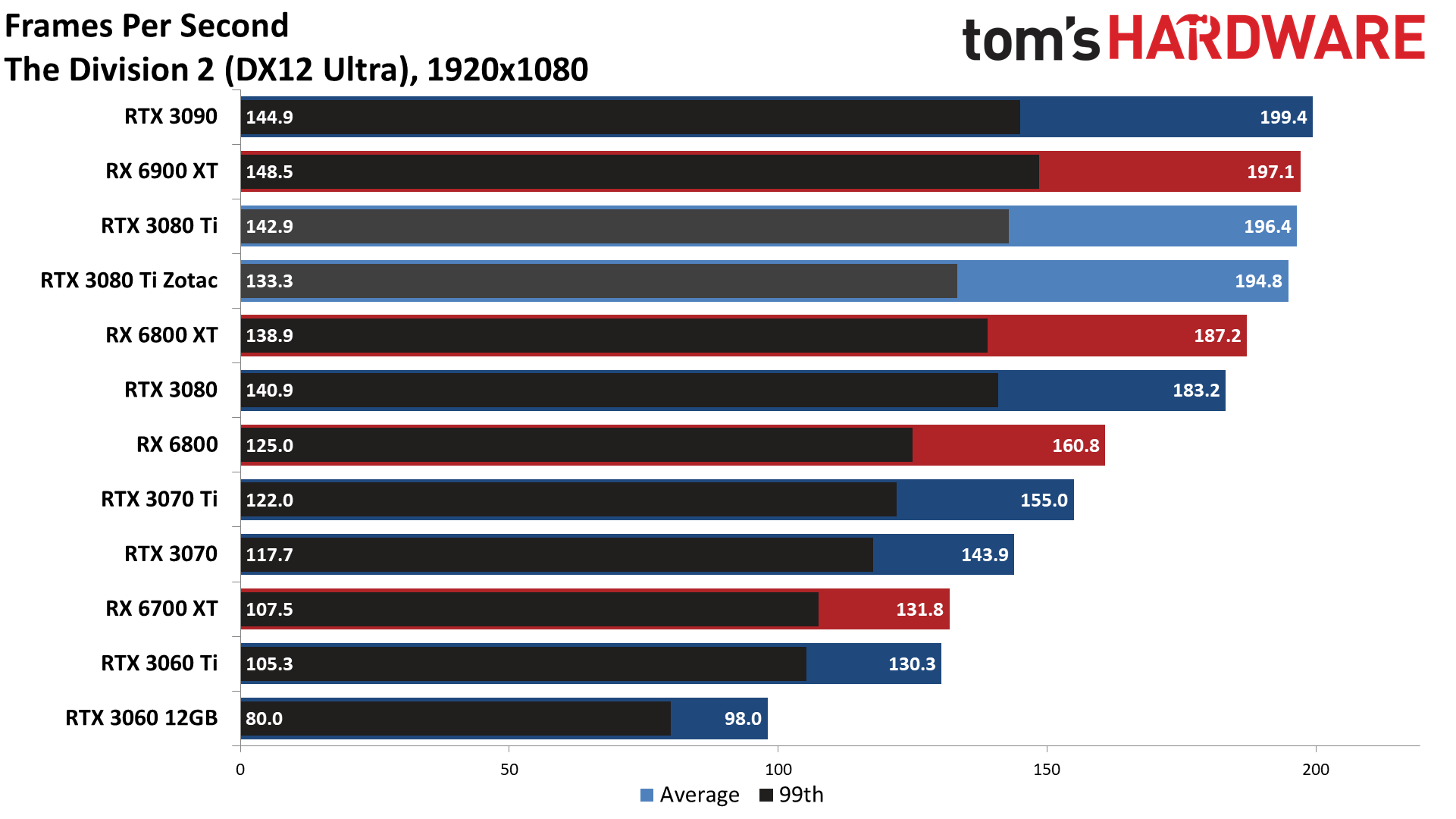
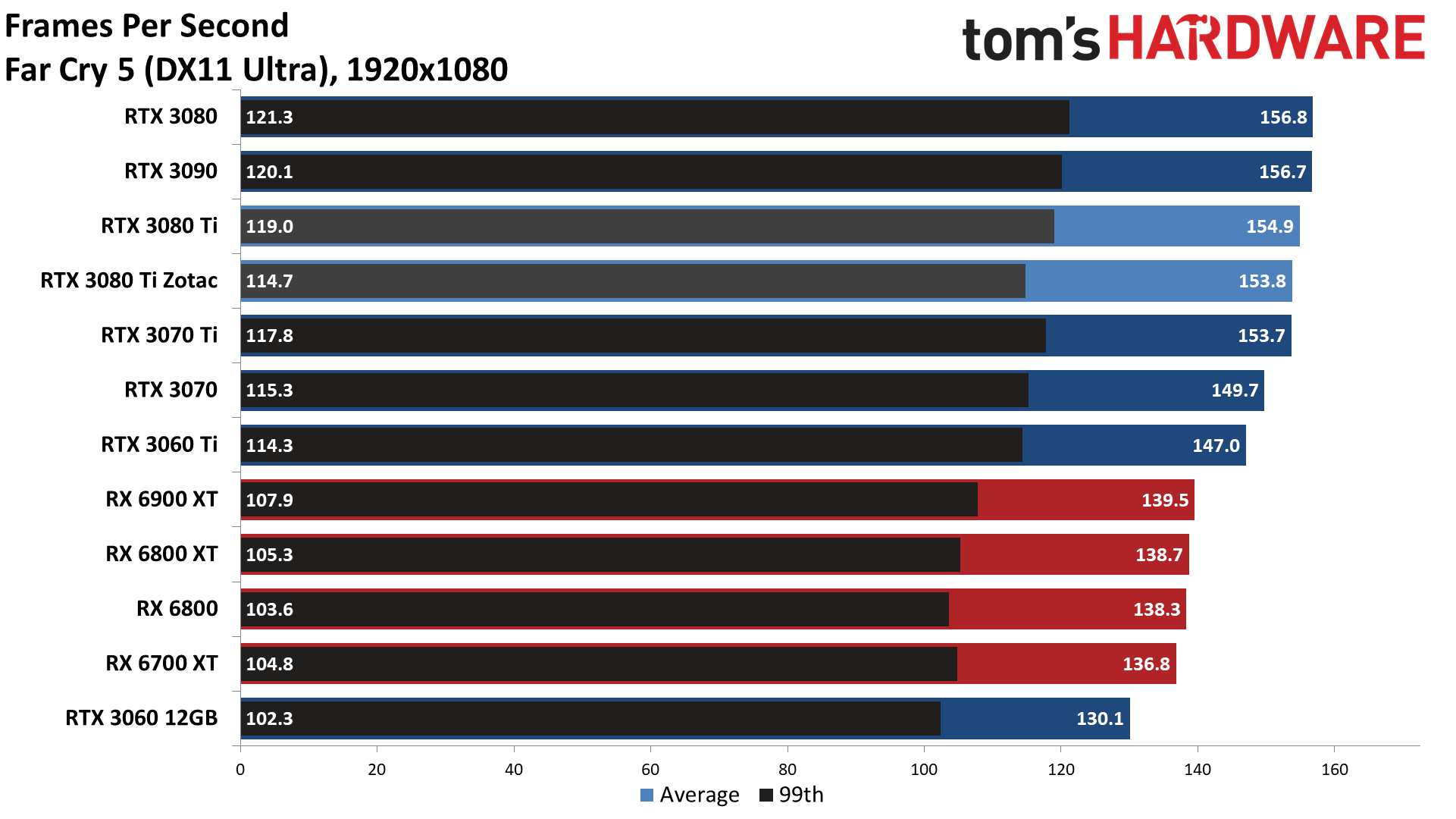
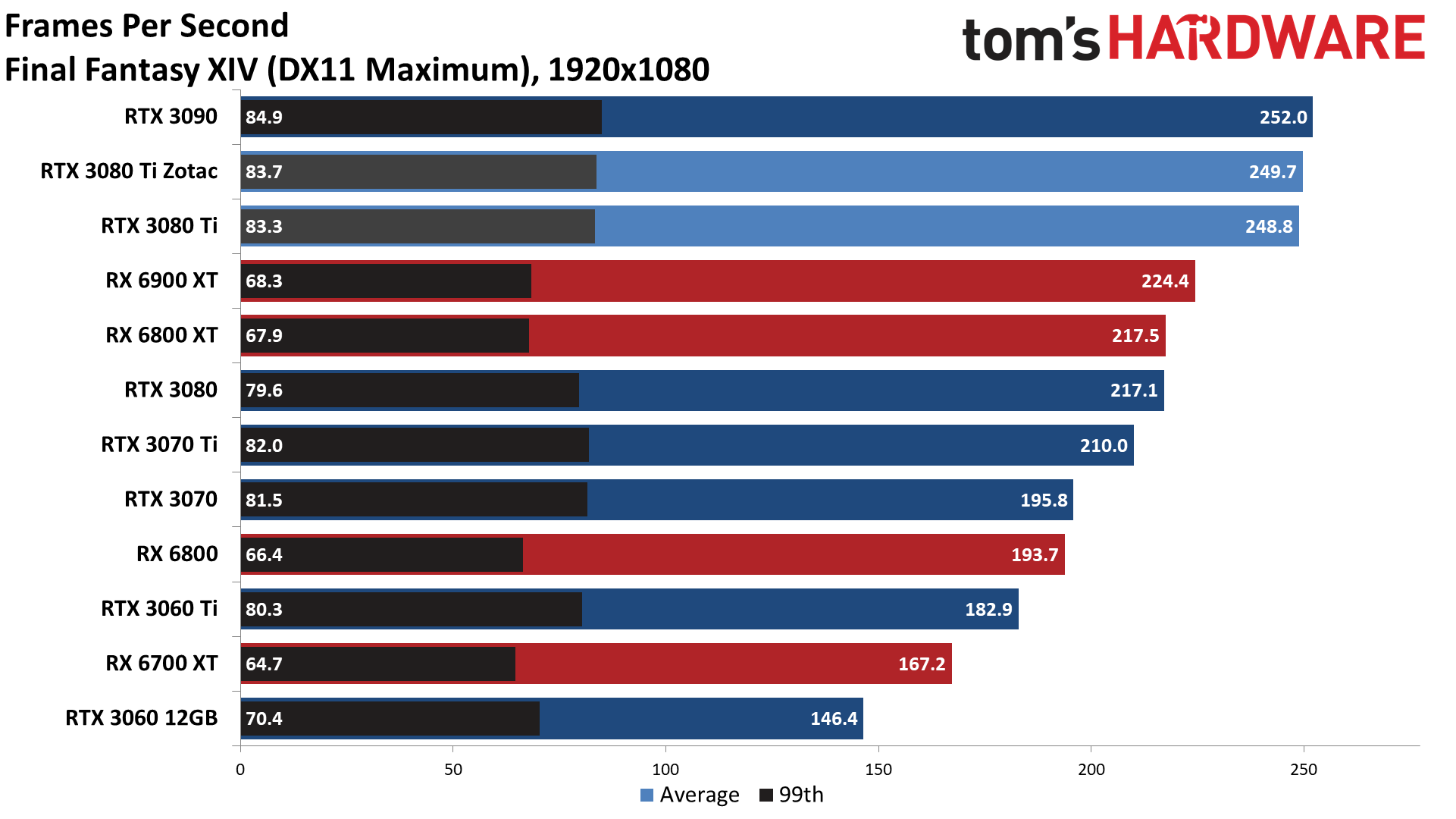
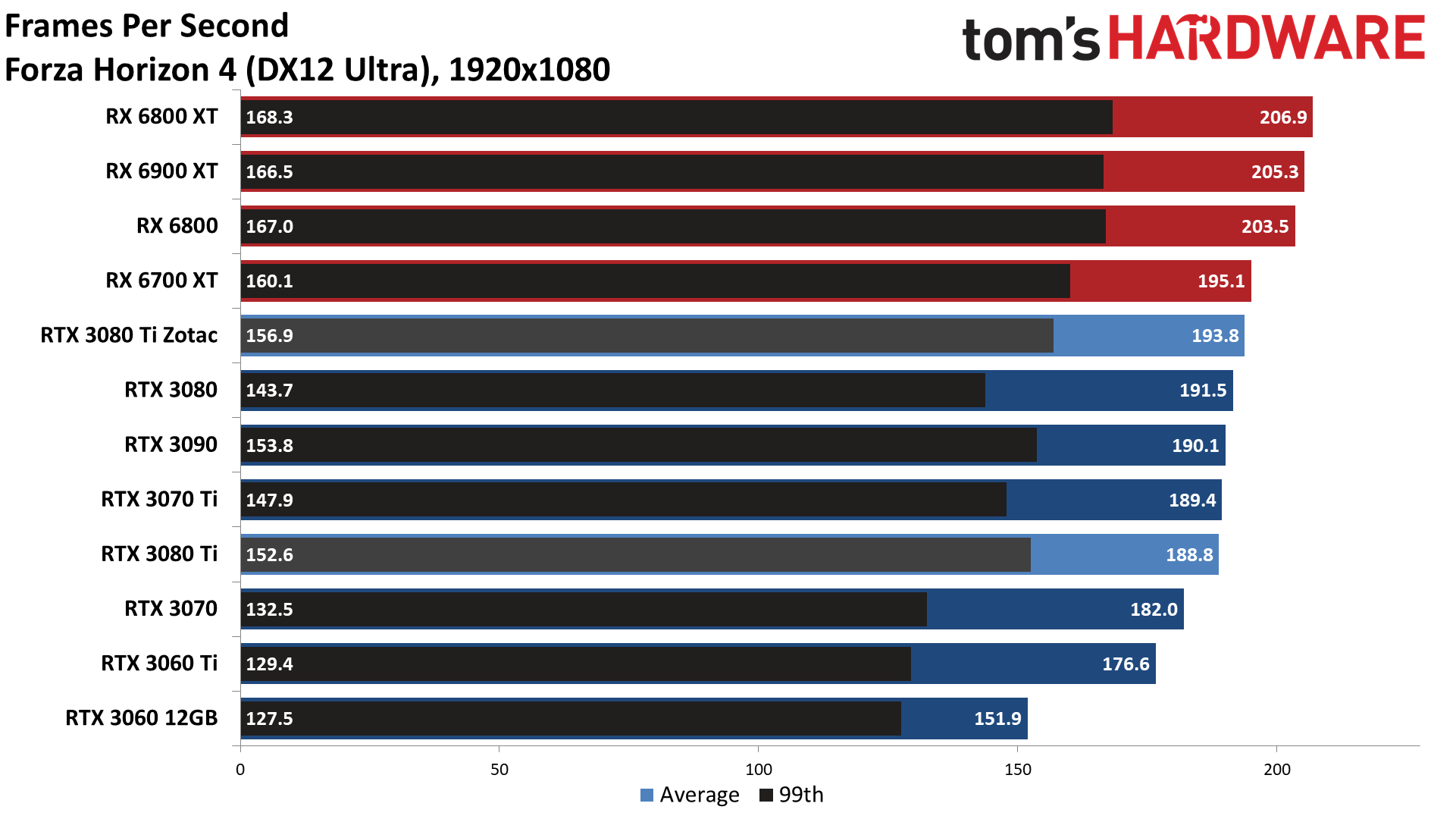

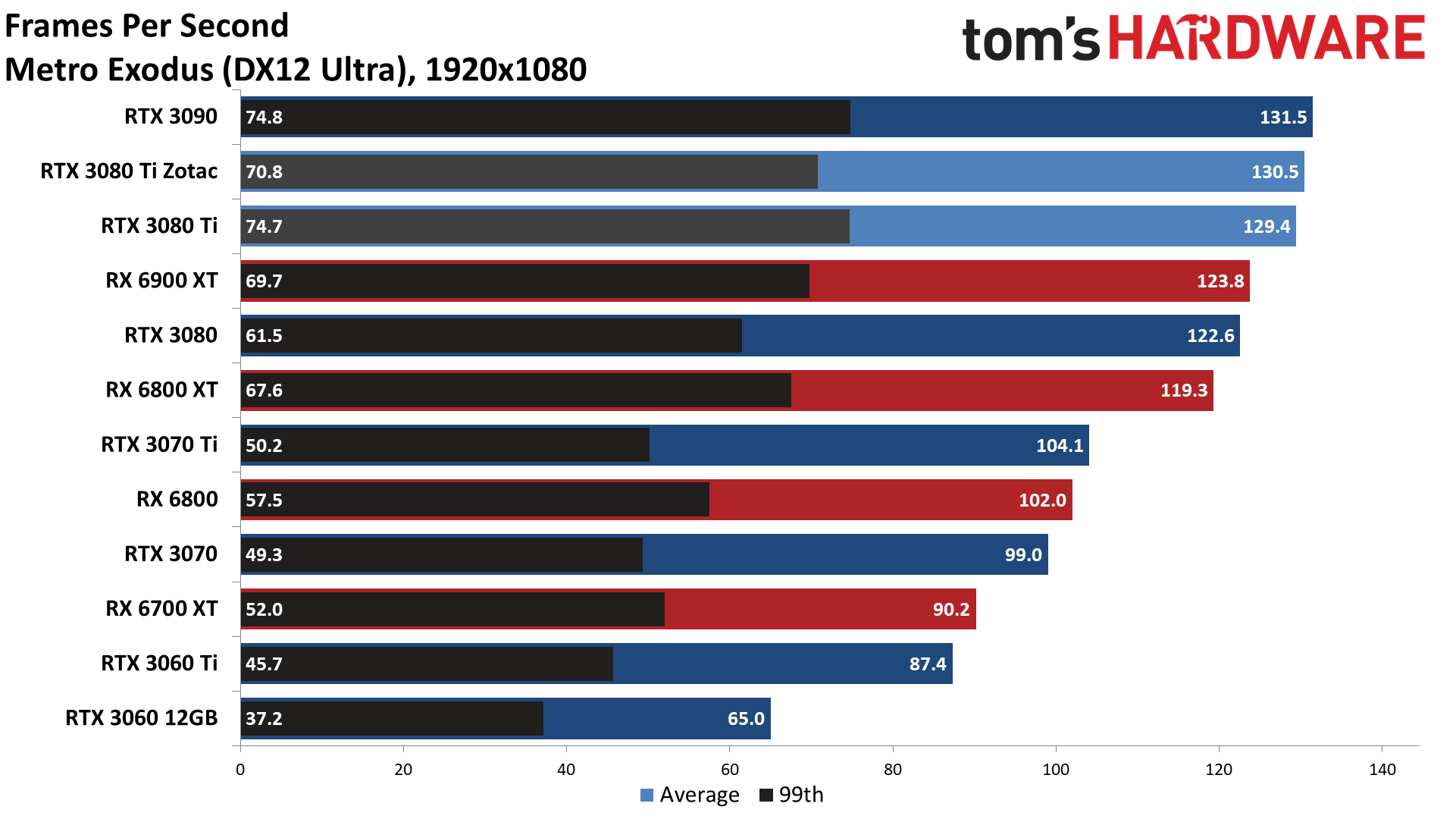

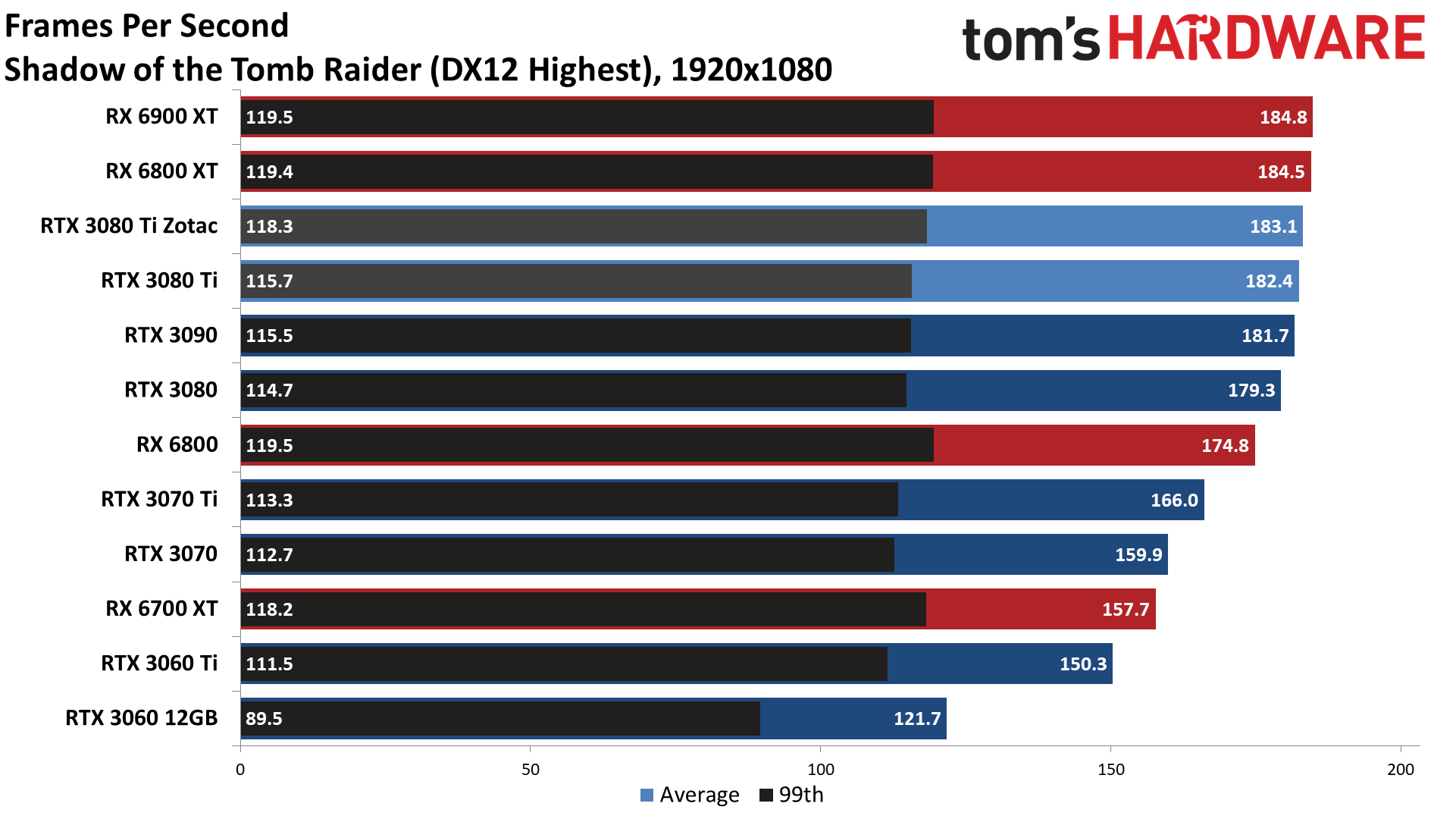


Last, at 1080p ultra, the Core i9-9900K becomes a bit more of a bottleneck. We're back down to almost identical performance (0.2% difference for Zotac), and the gap between the 3080 Ti and 3090 shrank to just over 1%. If we used a faster CPU, we might get closer to the theoretical 4% difference in raw performance, but 1080p gaming (at least without ray tracing) remains an easy hurdle for most modern GPUs to clear.
Zotac RTX 3080 Ti Amp Holo Power, Clocks, and Temperatures
Performance isn't the only important metric when it comes to graphics cards. We also test power consumption using in-line monitoring tools and Powenetics software. We log power, clock speeds, temperatures, and fan speeds, though the fan speed data wasn't properly reported by GPU-Z so we'll have to omit that. We loop the Metro Exodus benchmark five times at 1440p ultra settings, and then run FurMark at 1600x900 for over 10 minutes.
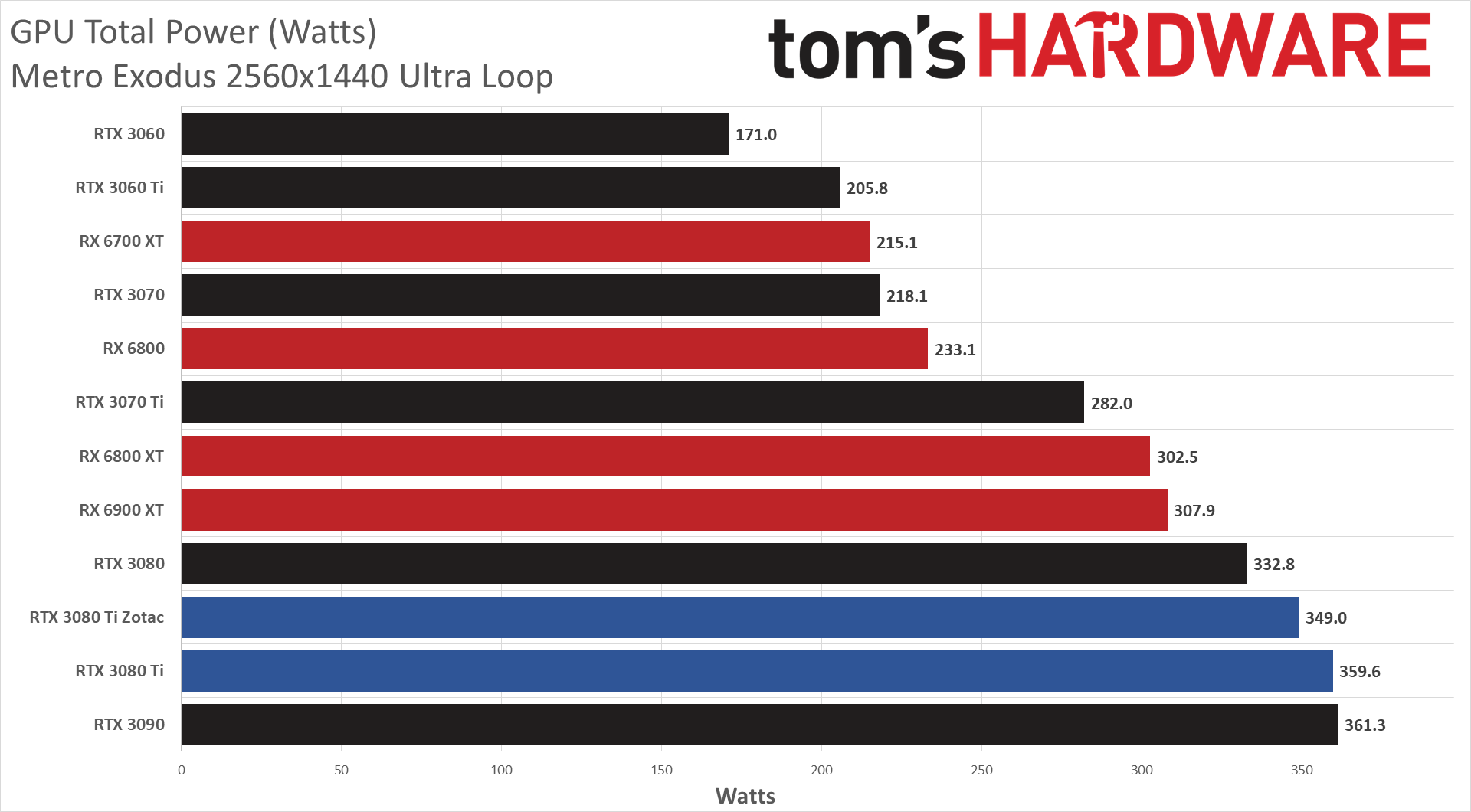
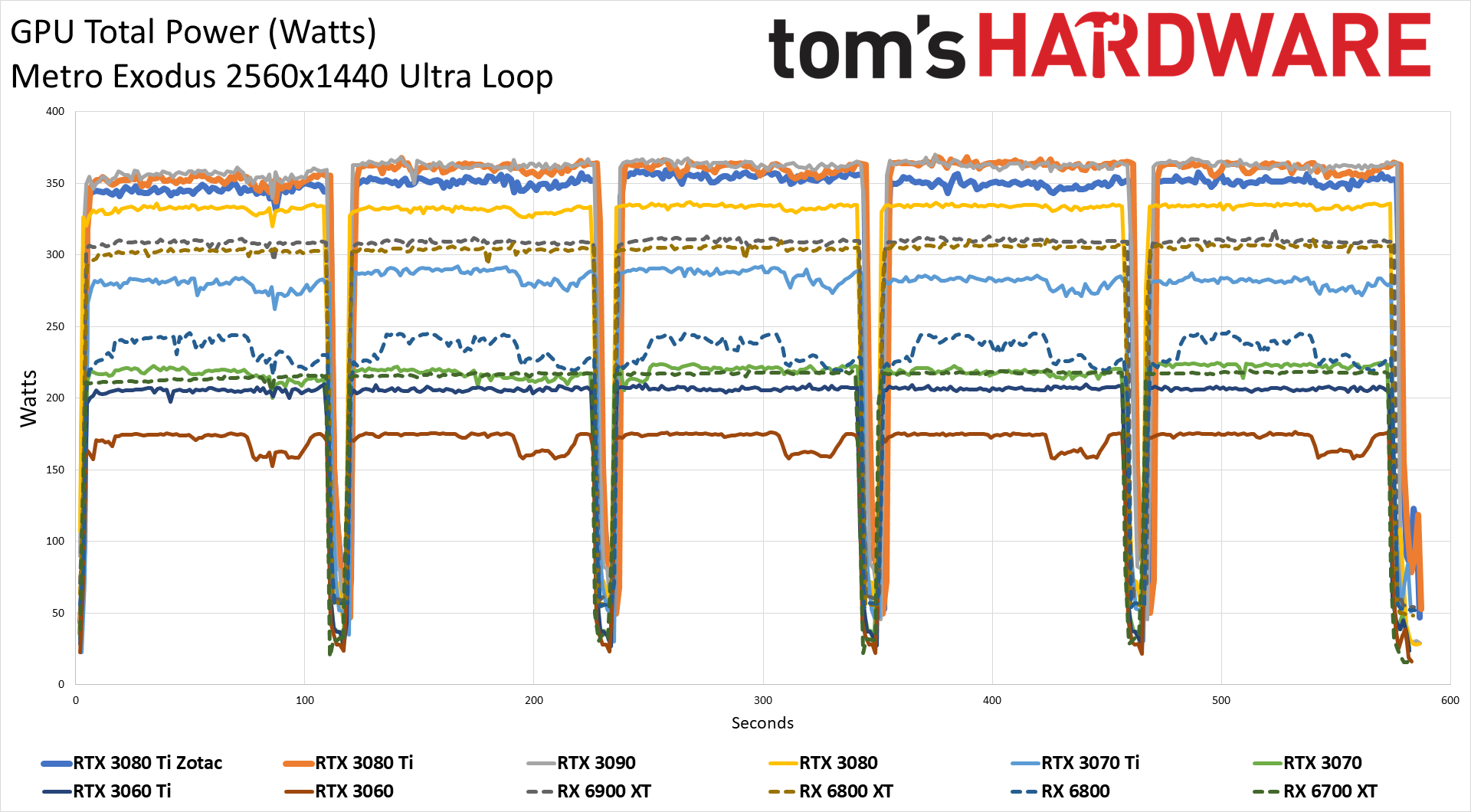
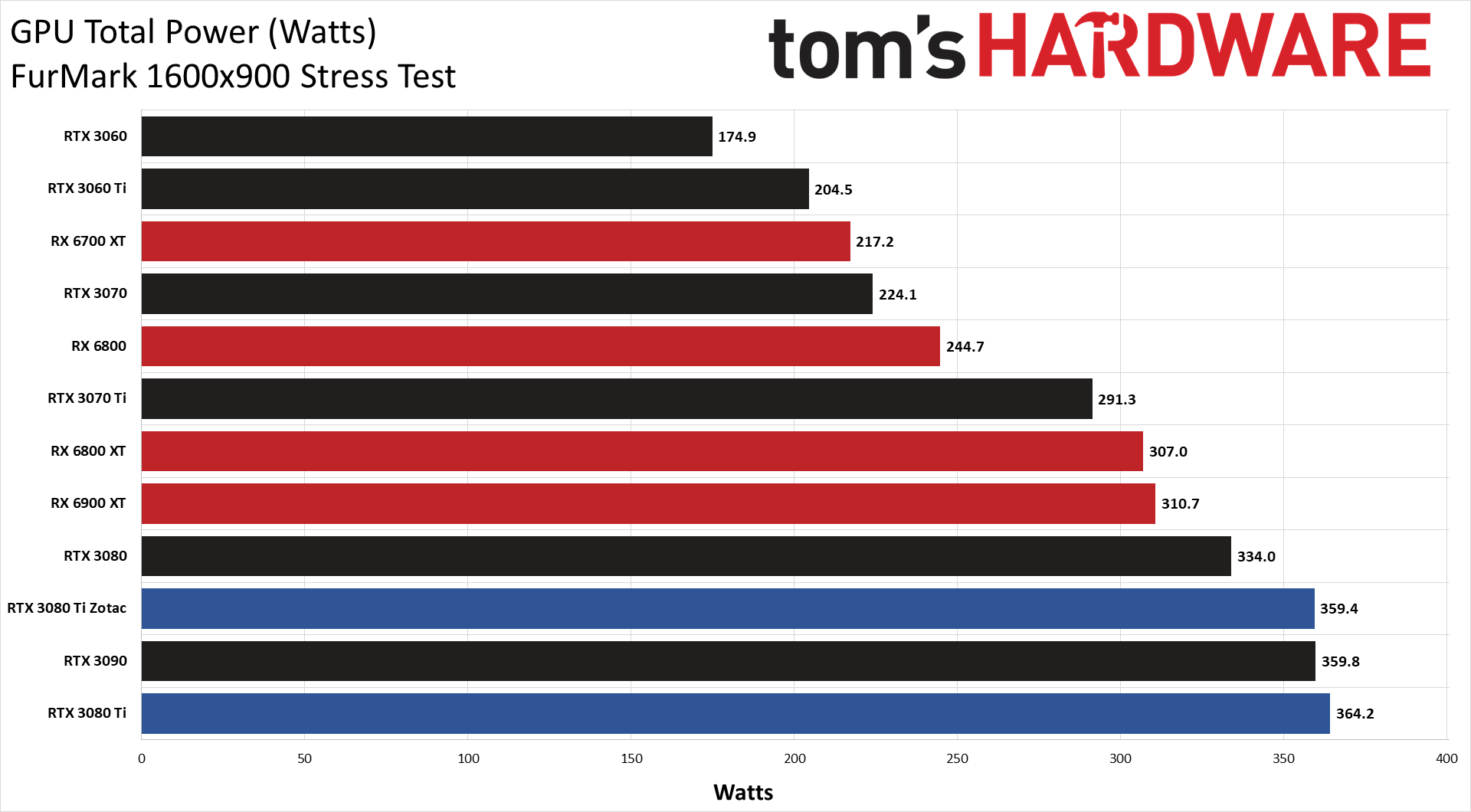

Power consumption for the Zotac 3080 Ti was a bit surprising at first, since factory overclocked cards often increase the power limits compared to the reference designs. The difference between the Amp Holo and the Founders Edition 3080 Ti wasn't significant, but in both FurMark and Metro Exodus the Zotac card used a bit less power—5W less in FurMark and 10W less in Metro. Once we factor in the other metrics, the reasons for the lower power use are easier to explain.
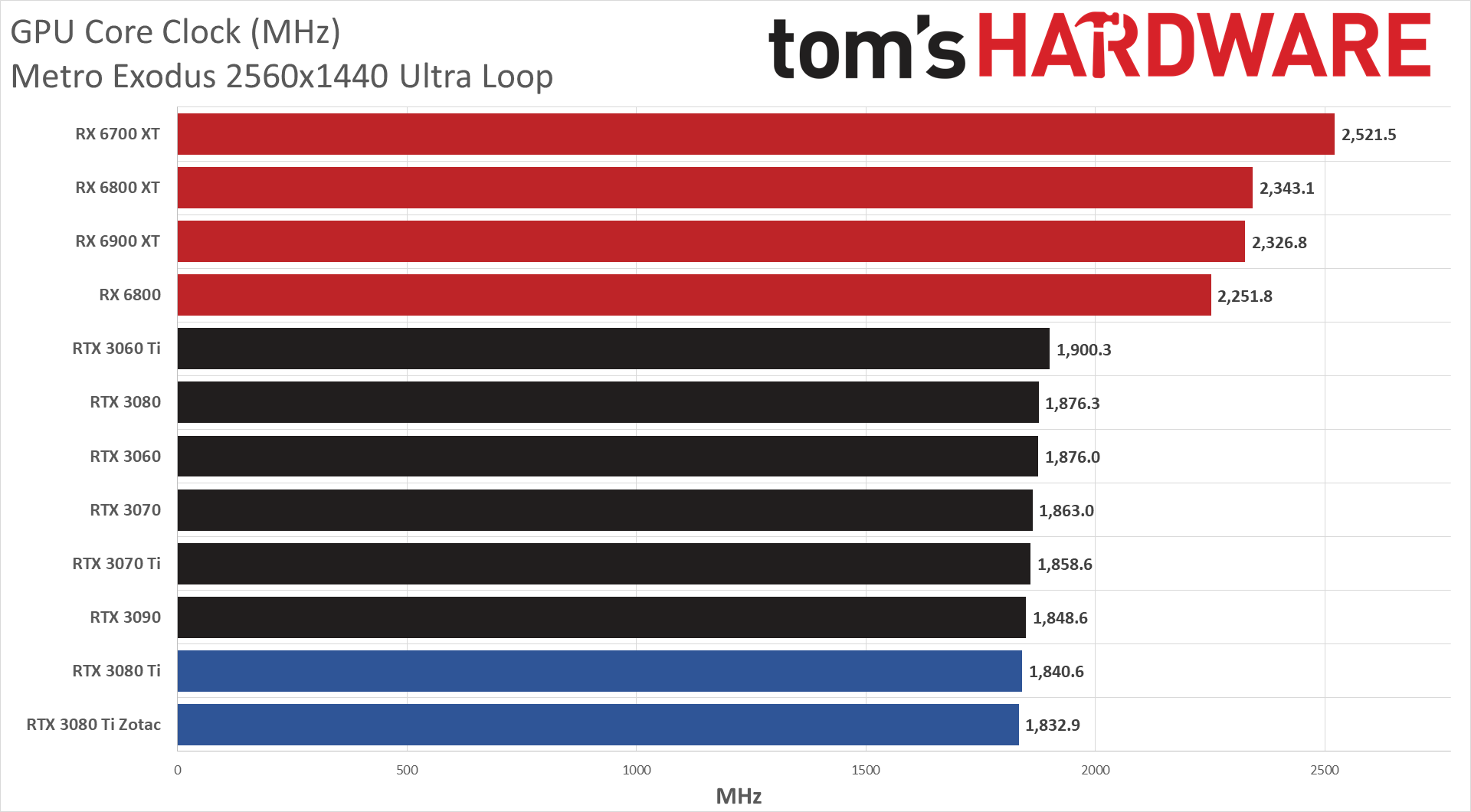
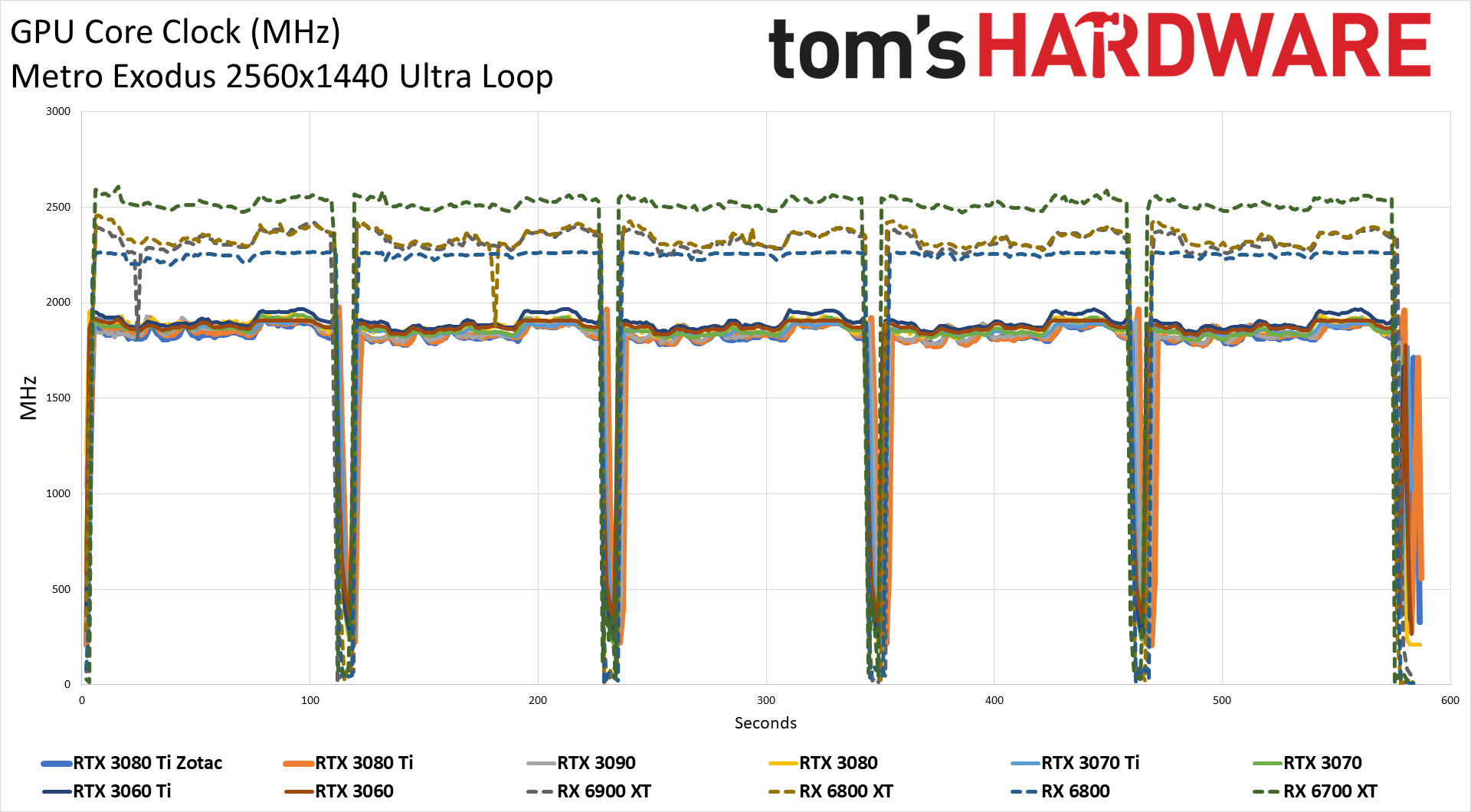
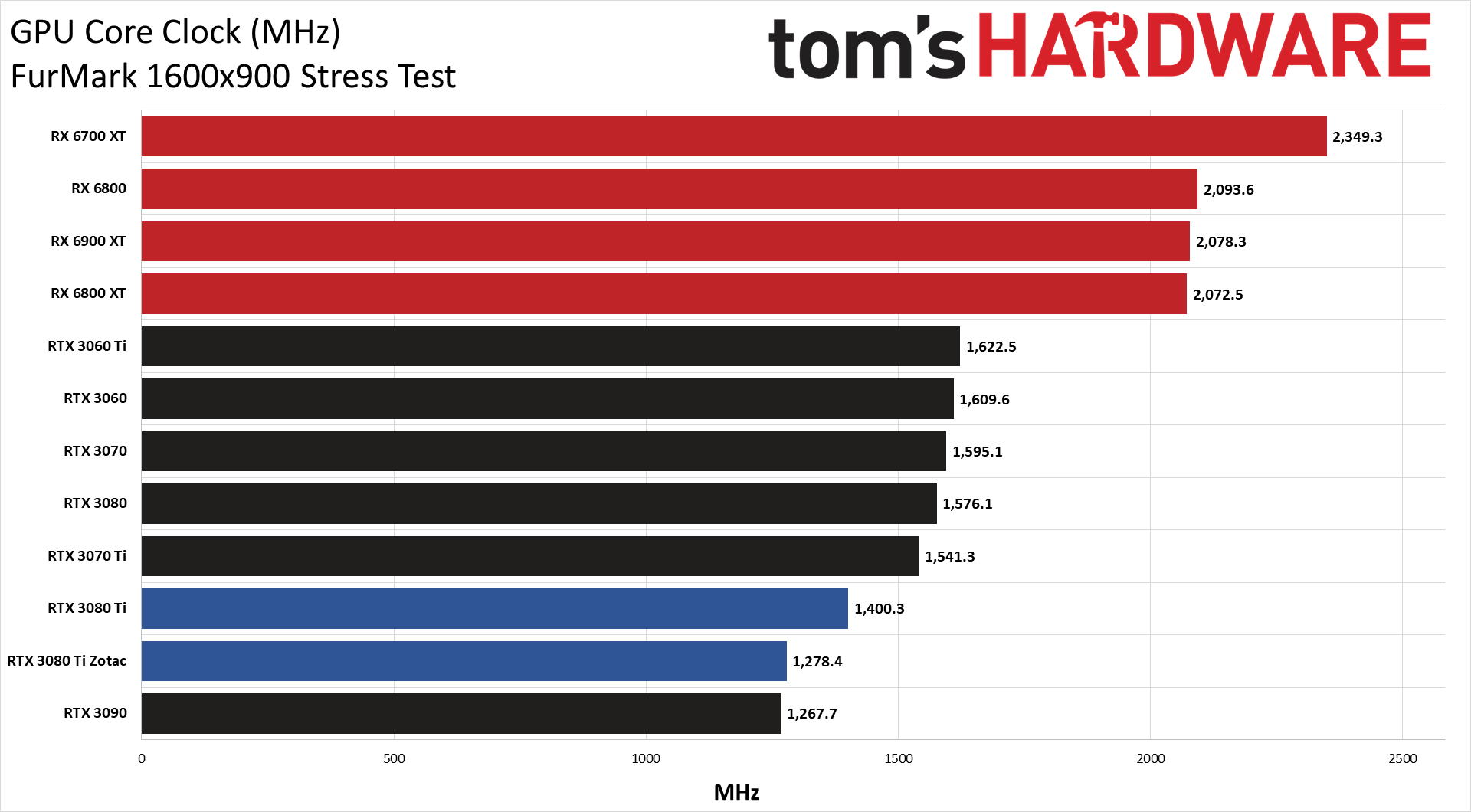
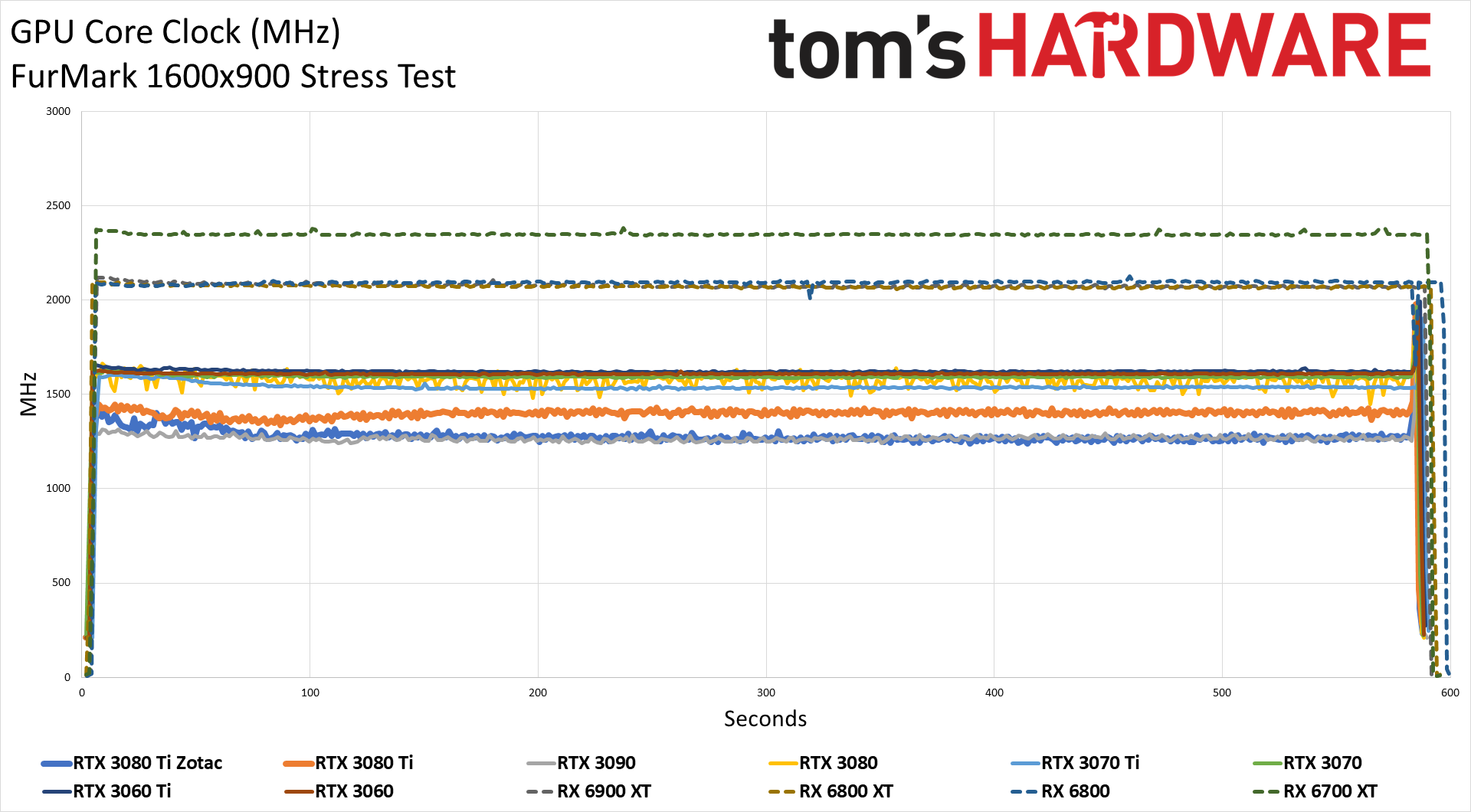
Despite having the same TDP with a slightly higher boost clock, our testing showed the Zotac card running at slightly lower average clock speeds in both FurMark and Metro. FurMark tends to push GPUs to their limits, and the Zotac card aggressively throttled clock speeds to compensate, but even in games it appears the Zotac card doesn't boost quite as high as the Founders Edition. That of course explains why it ended up using a bit less power, since power use scales directly with clock speeds.


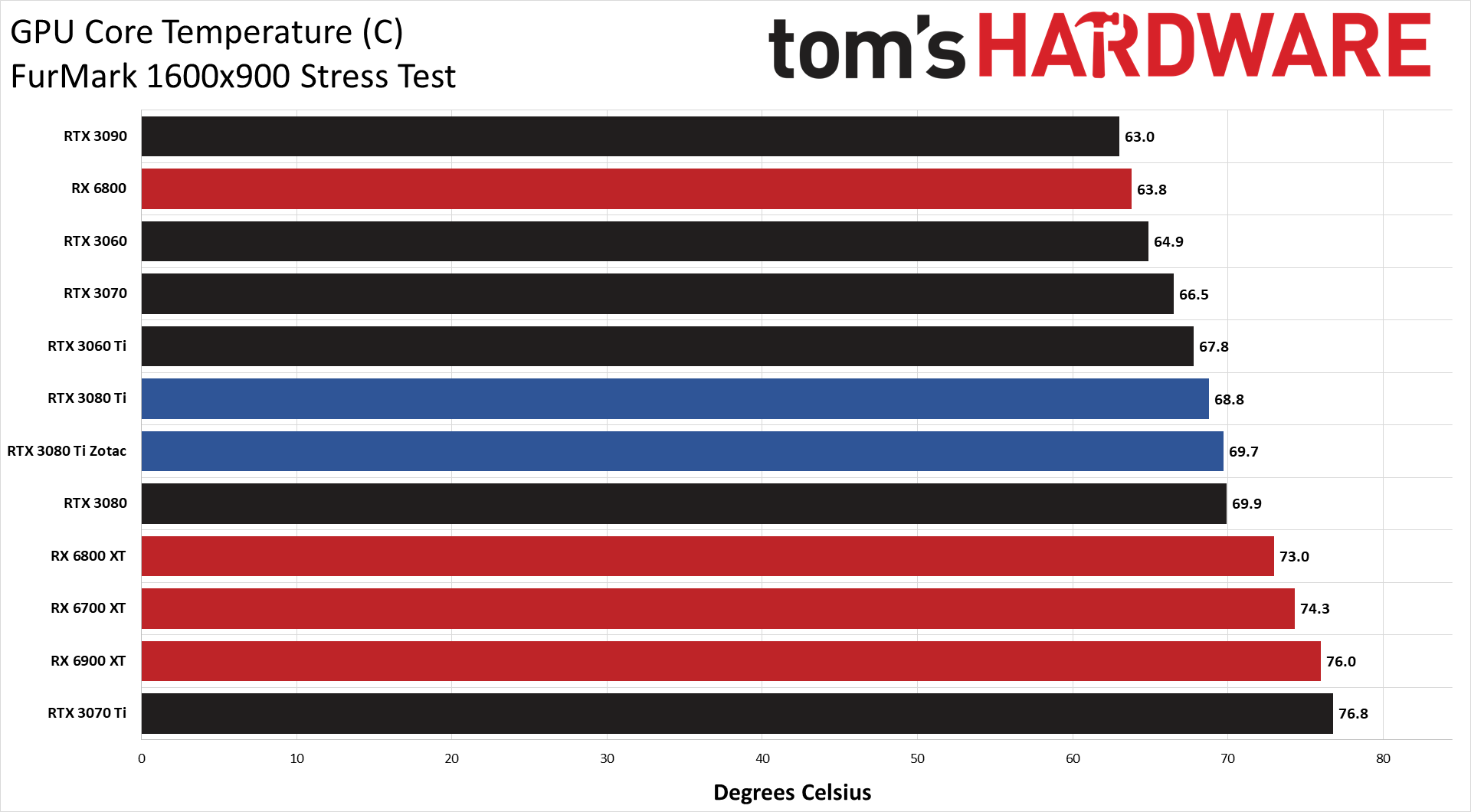
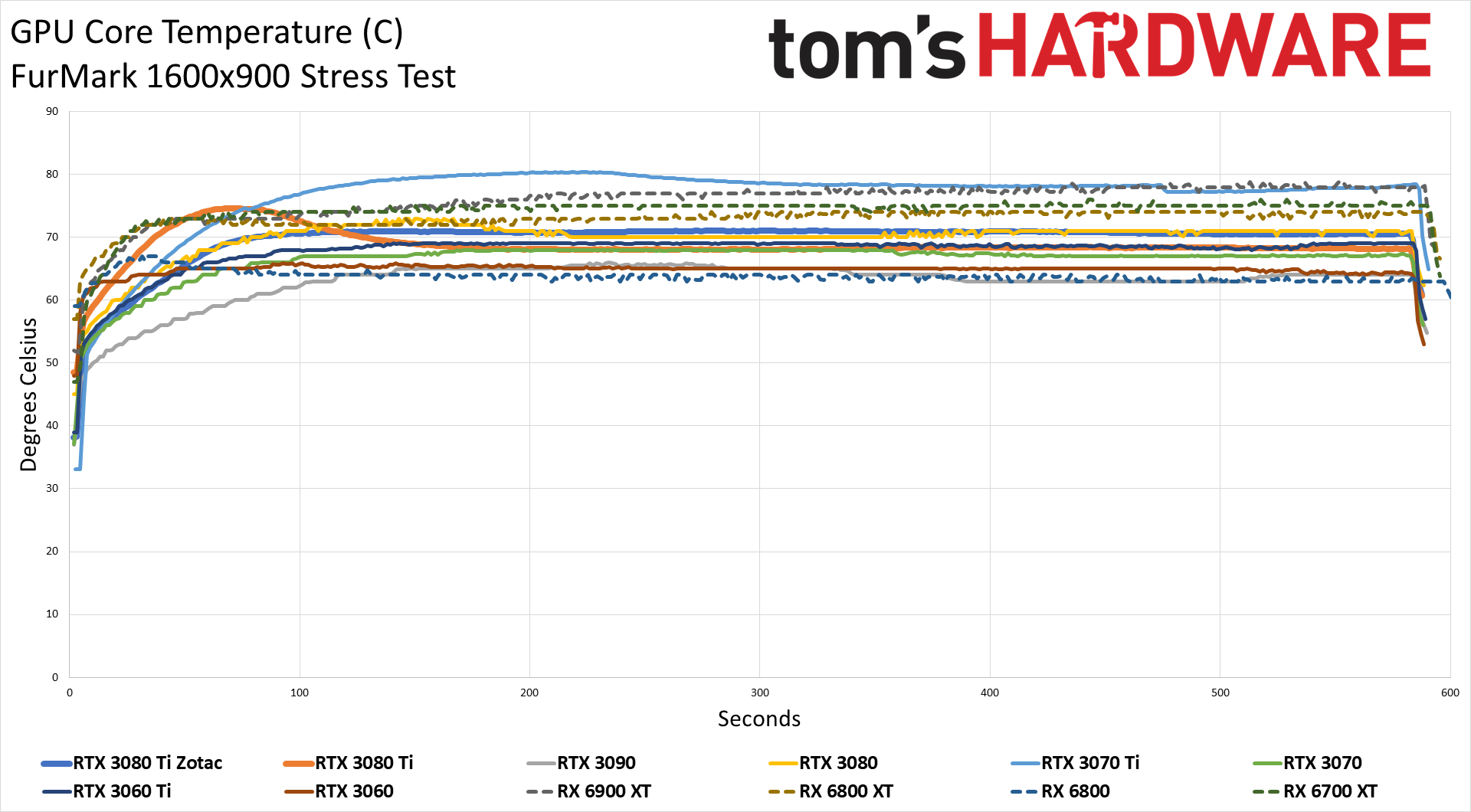
The other part of the equation is GPU and VRAM temperatures. The larger cooler on the Zotac card reduced temperatures by 1 degree Celsius in FurMark (not particularly noteworthy considering the lower clocks) and 4C in Metro Exodus. While we don't have a chart for it, GDDR6X temperatures also hovered at around 96C–98C on the Zotac card, compared to 100C–104C on the Founders Edition. Chip temperatures don't impact power use as much as clock speeds, but cooler chips do use a bit less power.
We also normally measure peak noise levels using an SPL meter, but a recent move has left that buried in a box, so we'll have to hold off on that a bit longer. Subjectively, the Amp Holo sounded perhaps a bit quieter than the Founders Edition while under full load, but we wouldn't want to guess at how much quieter it might be. It's likely within 1–2 dB, which won't be very noticeable once the card's installed inside a case.
Zotac RTX 3080 Ti Amp Holo: An Expensive Custom Card for Those Who Love Bling
Zotac didn't provide an official MSRP, so all we have to go on right now is the Newegg price, which at $1,800 feels incredibly high. The RTX 3080 Ti goes for even higher prices on eBay right now, but that's just another reason to hold off buying it. $1,200 for a card that's nearly as fast as the pseudo-Titan RTX 3090 is already more than we'd recommend spending on a GPU, unless you have very deep pockets and simply don't care about the cost—and if that's the case, why not spend a few hundred more for the slightly faster RTX 3090? But Zotac goes a step further with one of the highest retail prices we've seen so far on an RTX 3080 Ti. Only the Asus ROG Strix RTX 3080 Ti comes in higher, at $2,000, but we're not sure if the prices on Newegg are MSRPs or just Newegg price gouging. Either way, we wouldn't buy one at those prices.
The sad thing is that even at the massively inflated prices, all of the RTX 3080 Ti cards are still sold out. Considering the hash rate limiter, it's hard to imagine miners being the root cause, though we can't entirely rule them out. Regardless, gamers should be patient and wait for prices to come down. There's perhaps light at the end of the tunnel now, with GPU prices trending downward over the past few weeks. Barring a jump in mining profitability, we could see better availability at lower prices for all the Ampere and RDNA2 graphics cards before the end of the year. (Maybe—try not to get your hopes up.)
In a normal world, Nvidia would have launched the RTX 3080 Ti with a starting price of $1,000, and then the fastest and most feature rich third-party cards would have been priced at $1,100–$1,250. Our world remains anything but normal, unfortunately, which is why we have prices that are 50% higher than the base RTX 3080 Ti cards for effectively the same level of performance, plus some extra bling.
From the business perspective, we get it. The rules of supply and demand are such that when everything you produce immediately sells, and then often ends up being resold again at an even higher price, you're missing out on a chunk of the profits. Nvidia decided to take a piece of the pie, Zotac followed suit by claiming a similarly large slice, and we're still seeing RTX 3080 Ti cards going for $2,000–$2,500 on eBay. It's also much easier for a company to lower prices than to raise them—no one will complain if you offer to drop your price by 10–20%, while contractually it's very difficult to raise prices. But while we understand the rationale behind the higher prices, we absolutely do not like it and recommend you vote with your dollars by going elsewhere.
If you absolutely love the look of the Zotac RTX 3080 Ti Amp Holo, can find one in stock, and are willing to pay the high price premium, by all means go ahead and purchase one. Most gamers will be better off sitting this one out, because the one thing we know from historical GPU prices is that eventually they'll drop back to more reasonable levels. That might be in a few months, or it might take until next year, but the current prices definitely aren't sustainable over the long term.
MORE: Best Graphics Cards
MORE: GPU Benchmarks and Hierarchy
MORE: All Graphics Content

Jarred Walton is a senior editor at Tom's Hardware focusing on everything GPU. He has been working as a tech journalist since 2004, writing for AnandTech, Maximum PC, and PC Gamer. From the first S3 Virge '3D decelerators' to today's GPUs, Jarred keeps up with all the latest graphics trends and is the one to ask about game performance.
-
Joseph_138 If they're going to build a card that is more expensive than a 3090, then it should at least outperform a 3090. For .2 frames over a stock 3080 Ti, it's not worth the money. You can pick up .2 frames yourself using MSI Afterburner on a stock 3080 Ti, with no money spent. JayzTwoCents did a brief overview of the EVGA FTW3 card that actually outperformed a 3090 in some games, and is about $170 LESS than a 3090.Reply -
JarredWaltonGPU Reply
For GDDR6X, hitting peak temperatures of more than 100C is quite common. Spec lists 105C as the max, but I don't know what that measures compared to what the GPUs report. Anyway, if a bunch of other cards hit 102-104C max while gaming, and 110C while mining, then a card that only hits 96C gaming and 102C mining is indeed better.baha_timimi said:So.
Is 95 to 98 C is normal for the VRAM ?
Fixed, thanks.asuchemist said:Looks like the specs graph has the AMP listed as the FE. -
GoldRidley It's actually so much worse than the review lets on; at least for anyone hoping to overlock this. The card is advertised as having a 10% power boost taking it into the 375w region - this is false. It's totally disabled by the firmware. You can't ever get the numbers advertised for this card without flashing another manufacturer's bios, which is a hell of a risk.Reply -
baha_timimi Reply
Thanks for informationJarredWaltonGPU said:For GDDR6X, hitting peak temperatures of more than 100C is quite common. Spec lists 105C as the max, but I don't know what that measures compared to what the GPUs report. Anyway, if a bunch of other cards hit 102-104C max while gaming, and 110C while mining, then a card that only hits 96C gaming and 102C mining is indeed better.
Fixed, thanks.